

Hogwarts Legacy In the Shadow of the Mountain Walkthrough
February 6, 2023 by FranciRoosters Leave a Comment
In the Shadow of the Mountain is the forty-second main quest in Hogwarts Legacy. This walkthrough will guide you through all objectives of the In the Shadow of the Mountain Main Mission.
Requirement: having completed Professor Howin’s Assignment (Bombarda), Level 24 Reward: 260 XP Quest Info: Sebastian discovered more of Ranrok’s Loyalists swarming around another cavern. We decided to fight our way past them and find out what they were looking for. In our search we discovered more runes like the ones on the note from the triptych. We then battled a troll and a nasty infestation of spiders before finding the final piece to the triptych and another passageway back to the Undercroft. We returned and placed the final canvas in the triptych, unlocking a Pensieve memory. We watched it and learned that ancient magic has healing potential. Sebastian believes we can use this power to cure Anne.
Objectives:
Meet Sebastian Along the Coast
Travel up the switchbacks, defeat all the enemies, continue up the mountain, defeat the guards, enter the caverns, search for runes, defeat all of the enemies, unlock the rune door, search for the triptych segment, defeat the troll.
- Investigate the Chamber
Use the Magic Passageway
Place the canvas into the triptych, starting location: in the shadow of the mountain.
We’ve learned Bombarda, the Exploding Charm, which should allow us to get through the mountain and reach the southern regions. There, we must meet with Sebastian.

In order to access the southern regions, you need to head through a mine. You can’t fly or walk there, the only way is through a mine. Refer to the screenshots below to find the entrance.

You’ll eventually head back outside and be able to fly again. Once you can, proceed to the quest marker and talk to Sebastian.

Now clear the area.
Now clear the area again.
Loot the area, making sure you activate the Tower Tunnel floo flame here, then enter the caverns at the quest marker.
Continue down the tunnels and kill the spiders. Loot the area, including the area behind a Bombarda wall for a chest , then continue down the slope. In the next area, defeat some more spiders, loot the area and continue on. Go up the staircase, burn the spider web, then blow up the wall with Bombarda.

Then, continue down the spider egg tunnel.
Now kill some more spiders in the arena.
Now loot the area, including the spider nest where the two Matriarchs came rushing from. Then, face the door and cast Confringo at the spider web covering the rune switch right of the door. Then, hit the one behind you and the two by the door.

Go through the door and you’ll find Isidora’s Journal Entry 4/7 in an open chest in front of you, then continue on and you’ll have to fight a mountain troll.

Now defeat the troll and spiders.

Now resume your search for the segment. Loot the area, including the small room behind the wooden barricade. In there ignite the bowl by the statue to reveal a small chest . Now return to the main room and use Reparo on the shambled stairs.

Climb up the stairs and loot the next room, including Isidora’s Journal Entry 5/7, then move the crate by the cracked wall to be able to climb it.

Climb up the stairs on the right and loot the floor, then go back down and climb up the stairs on the left. Now continue to the next few quest markers, there’s only one way to go, you can’t get lost. Inside the new room is Isidora’s Journal Entry 6/7 on a table.

Loot the room, including igniting the bowl by the statue to reveal a chest , then use Bombarda on the wall. Go up the slope, jump over the gap, grab the chest from the alcove on the right, then continue on.
In the next room are two more rune switches, with the third hidden behind a Bombarda wall next to the door. Hit all three and continue through the door.

Investigate the Chamber
Inside the new room will be the final piece of Isidora’s Journal 7/7 on a table. Now go up the stairs and immediately turn around to the left and go up the ledge to find some loot, then pick up the final piece of the triptych on the table.

Now proceed to the crystallized door to return to the Undercroft.

Now approach the triptych and place the last piece of the canvas inside it.

This finishes In the Shadow of the Mountain in Hogwarts Legacy.
Next Quest: Lodgok’s Loyalty
For all other quests refer to the Hogwarts Legacy Walkthrough .
Leave a Reply Cancel reply
Your email address will not be published. Required fields are marked *
- Terms of Service
- Privacy Policy
- Cookie Policy
- Aion Classic
- Alone in the Dark
- Baldur's Gate 3
- Cyberpunk 2077
- Dead by Daylight
- Death's Door
- Dice Legacy
- Final Fantasy X/X-2
- Going Medieval
- Gotham Knights
- Hearts of Iron IV
- Hogwarts Legacy
- Sons of the Forest
- Stranger of Paradise: Final Fantasy Origin
- The Callisto Protocol
- The Elder Scrolls Online
- The Elder Scrolls V: Skyrim
- The Forgotten City
- The Outer Worlds
- The Witcher 3: Wild Hunt
In the Shadow of the Mountain – Hogwarts Legacy Quest
- Published February 18, 2023
- Updated February 19, 2023

The Path to Hogwarts

Welcome to Hogwarts

Defence Against the Dark Arts Class

Charms Class

Weasley After Class

Welcome to Hogsmeade

The Locket’s Secret

Secrets of the Restricted Section

Tomes and Tribulations

Herbology Class

Potions Class

The Girl from Uagadou

Trials of Merlin

Scrope’s Last Hope
The Hunt for the Missing Pages
Prisoner of Love
Ollivander’s Heirloom

Jackdaw’s Rest
Flying Class

In the Shadow of the Undercroft

The Room of Requirement

The Map Chamber

Percival Rackham’s Trial

Beasts Class

The Caretaker’s Lunar Lament

The Helm of Urtkot

In the Shadow of the Estate

The Elf, the Nab-Sack, and the Loom

The High Keep

Astronomy Class

Back on the Path

Charles Rookwood’s Trial

Fire and Vice

It’s All Gobbledegook

In the Shadow of the Mine

The Headmistress Speaks

The Polyjuice Plot

Niamh Fitzgerald’s Trial

In the Shadow of the Mountain

Lodgok’s Loyalty

San Bakar’s Trial

Wand Mastery

The Final Repository

Weasley’s Watchful Eye

The House Cup

Professor Ronen’s Assignment

Professor Hecat’s Assignment 1

Professor Hecat’s Assignment 2

Professor Sharp’s Assignment 1

Professor Sharp’s Assignment 2

Professor Garlick’s Assignment 1

Madam Kogawa’s Assignment 1

Professor Garlick’s Assignment 2

Madam Kogawa’s Assignment 2

Professor Onai’s Assignment

Professor Howin’s Assignment

Professor Weasley’s Assignment

Like a Moth to a Frame

Crossed Wands: Round I

Crossed Wands: Round II

Flying Off the Shelves

Gobs of Gobstones

Cache in the Castle

Spell Combination Practice 1

Spell Combination Practice 2

Crossed Wands: Round III

Venomous Valour

‘Dissending’ for Sweets

Interior Decorating

The Daedalian Keys

Summoner’s Court: Match 1

‘Mer-ky’ Depths

Summoner’s Court: Match 2

The Hall of Herodiana

The Tale of Rowland Oakes

The Man Behind the Moons

The Plight of the House-Elf

Summoner’s Court: Match 3

‘Beeting’ a Curse

Foal of the Dead

All’s Well That Ends Bell

Summoner’s Court: Match 4

History of Magic Class

Phoenix Rising

Portrait in a Pickle

Summoner’s Court: Match 5

Follow the Butterflies

Flight Test

A Demanding Delivery

Sweeping the Competition

A Friend In Deed

Venomous Revenge

Take the Biscuit

The Unique Unicorn

Spot Removal

The Sky Is the Limit

Tangled Web

Minding Your Own Business

The Lost Astrolabe

Carted Away

Breaking Camp

Brother’s Keeper

Troll Control

Ghost of Our Love

E-vase-ive Manoeuvre

Kidnapped Cabbage

Absconder Encounter

A Thief in the Night

Solved by the Bell

Birds of a Feather

Sacking Selwyn

Rescuing Rococo

The Hippogriff Marks the Spot

Cursed Tomb Treasure

In the Shadow of the Bloodline

In the Shadow of the Study

In the Shadow of Discovery

In the Shadow of Time

In the Shadow of Distance

In the Shadow of Hope

In the Shadow of the Relic

In the Shadow of Fate

In the Shadow of Friendship

The Lost Child

Mum’s the Word

A Basis for Blackmail

Grief and Vengeance

Finding Focus

Harlow’s Last Stand

Acting on Instinct

A Dragon Debrief

Poached Egg

The Poachers’ House Call

Surprise Meeting

The Centaur and the Stone

It’s in the Stars

A Bird in the Hand

Poppy Blooms

How to Solve All Puzzle Doors

Arithmancy Classrooms’s Puzzle Doors

Charms Classroom’s Puzzle Door

Grand Staircase’s Puzzle Door

Grand Staircase Tower’s Puzzle Door

Ravenclaw Tower’s Puzzle Door

Great Hall’s Puzzle Door

Central Hall’s Puzzle Door

Faculty Tower’s Puzzle Door

Bell Tower’s Puzzle Door

Long Gallery’s Puzzle Door

- Quest Type: Main Story
- Location: Marunweem Lake ( map )
- Complete Niamh Fitzgerald’s Trial

Meet Sebastian along the coast
This is one of the trickier quests to start, particularly if you haven’t unlocked any of the Floo Flames in the southern part of the World Map. When you open your world map, you might not be able to see the quest location for In the Shadow of the Mountain at all if you aren’t at least as far south as Poidsear Coast . We have a guide for How to Get to Poidsear Coast , but in brief: go to the location indicated below (1) and make your way through the large tunnel (2) — at the other side of it you’ll be able to unlock the North Poidsear Coast Floo Flame.
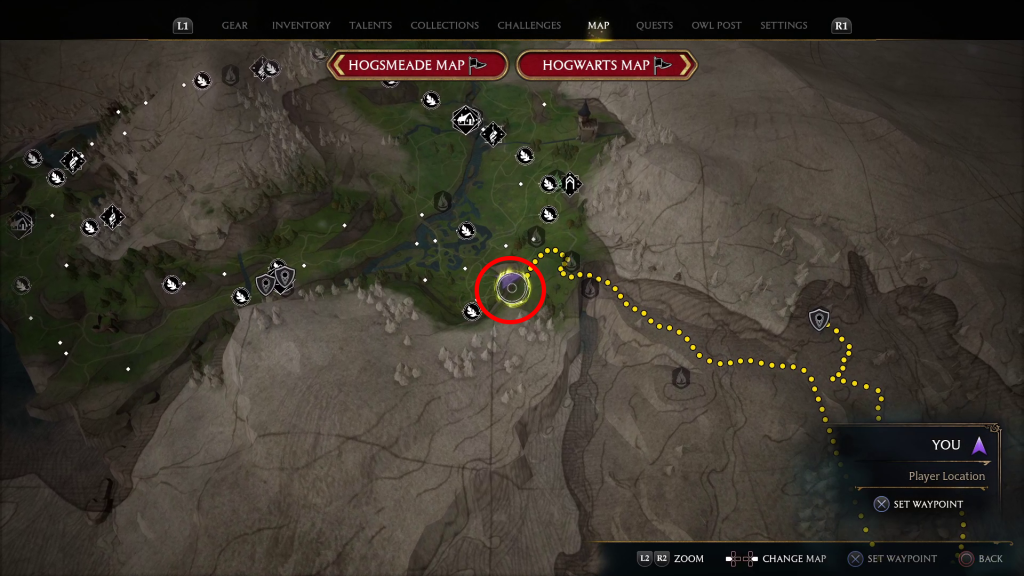
Travel up the switchbacks
After you finish speaking with Sebastian, you’ll need to head southwest, following the path up the mountain. Where the path bends you’ll find a small group of goblins. You can easily sneak past them, take them out while stealthed, or just blast them — whatever you prefer. Continue up the mountain, now heading east-southeast.

Once you’ve done everything you want in this area, go back through the gap you cleared of brambles and turn left to keep following the path up the mountain. You’ll soon come to a wooden gate with a bunch of goblins hanging around in the mining camp beyond.
Defeat All Enemies

Continue up the mountain
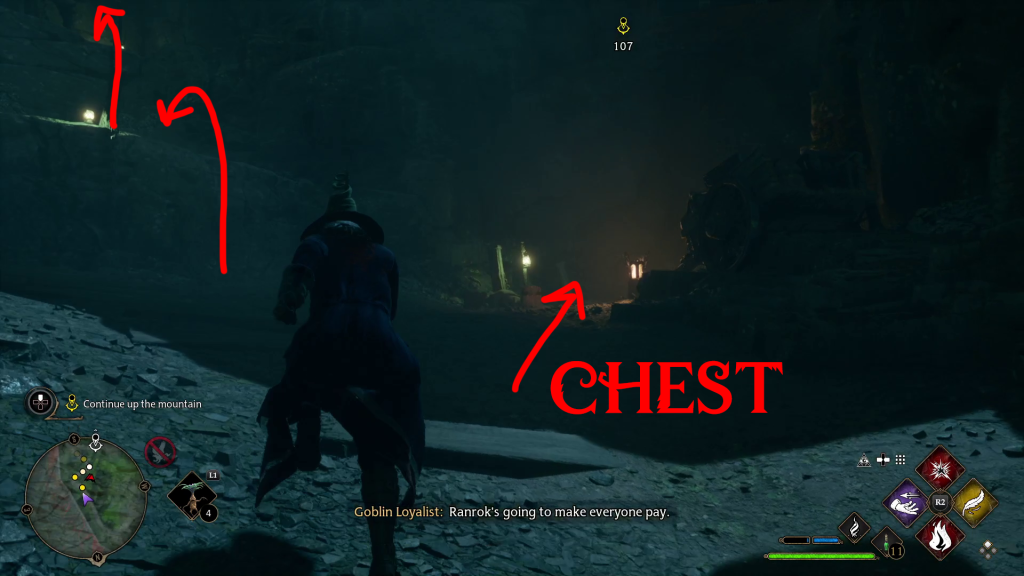
Defeat the Guards
Enter the caverns.

Search for Runes

Defeat all of the enemies
Unlock the Rune Door

Search for the triptych segment
Defeat the troll.

Search for the triptych segment (2)

Don’t rush around the corner ahead — after turning right, you’ll need to leap across a gap to continue north. After jumping the gap, turn right to find a chest, then go north up the stairs.
Open the Rune Door
You’ll enter another room with a Rune Door. Around the corner to the west is another wall of rocks you can remove with Depulso — doing so will reveal one of the Rune Door panels (1). The other two are to your left (2) — shoot the first one, then run towards the other two and Basic Cast them as quickly as you can. Once you successfully hit all three quick enough, the door that leads west will open, and you can head through.

Investigate the chamber

Use the magic passageway
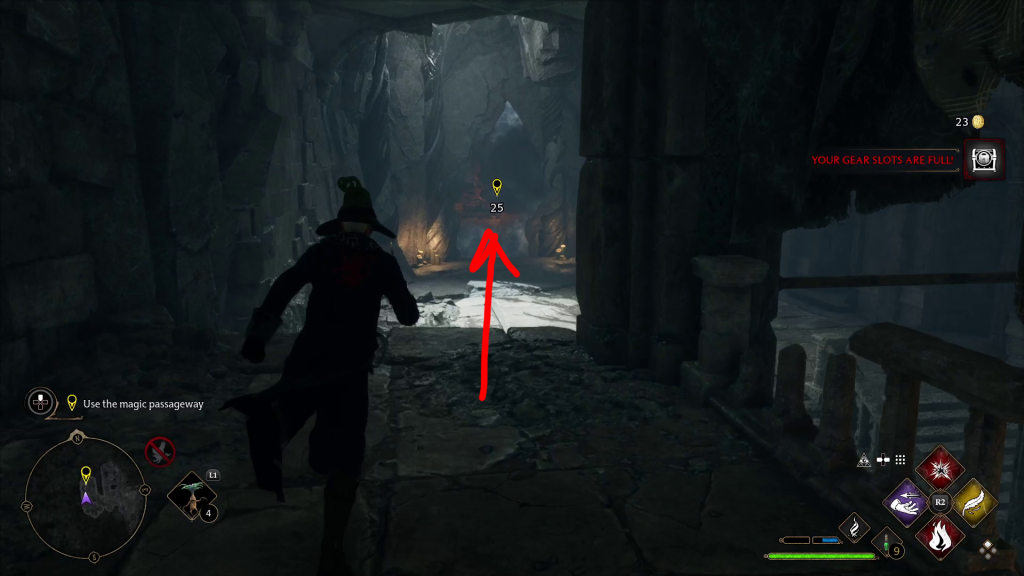
Place the canvas into the triptych

When the memory ends, you’ll speak once more with Sebastian, and this the quest will end, leaving us with just as many questions as when started. The next main story quest is Lodgok’s Loyalty — with any luck, we’ll learn a bit more about just what Isidora was doing when we meet up with the goblin.

Return to Main Menu

Unabashed FromSoftware fanboy still learning to take his time with games (and everything else, really). The time he doesn't spend on games is spent on music, books, or occasionally going outside.
Welcome to EIP Gaming!
EIP Gaming is a site for gamers looking for gaming guides and gaming news ! We cover a variety of games including World of Warcraft, Cyberpunk 2077 , Fallout 4 , HOI4 , Final Fantasy X/X-2 , Skyrim , Valheim , The Outer Worlds , Dead by Daylight , Death's Door , The Forgotten City , ICARUS , Elden Ring , Sifu , Stranger of Paradise: FFO , Hogwarts Legacy , Starfield , Rust , Stray , Gotham Knights , Sons of the Forest , Baldur's Gate 3 , and other AAA and indie game titles.
Our detailed guides will help you enhance your gaming experience, improve your gameplay, and help you gain efficiency!
Follow On Us
Recent Updates

5 of the Best Fallout Mods in 2024 – Welcome Back to the Wasteland

Dead Island 2 SoLA Review — Playing the Bloody Hits (Live)

Moonrise Towers – Baldur’s Gate 3
Our Communities

Hogwarts Legacy Walkthrough & Guides Wiki
- Walkthrough
- Side Quests
- Tips & Tricks
- Interactive Map
- Collectibles
Quest Walkthrough
In the Shadow of the Mountain Quest Walkthrough

★ List of All Treasure Map Quests ★ Best Side Quests to Do First | Best Optional Quests ★ How to Complete Dueling Feats ★ Best Spell Combos ★ Farm Gold Fast ★ Post-Game Content Guide
In the Shadow of the Mountain is a main quest in the Sebastian Sallow quest line of Hogwarts Legacy. Read on for a detailed walkthrough, list of rewards, and tips on how to complete In the Shadow of the Mountain!
List of Contents
Previous and Next Quests
- Related Guides
In the Shadow of the Mountain Overview
How to unlock.
The In the Shadow of the Mine main quest unlocks after completing Niamh Fitzgerald's Trial . You must also reach level 24 and learn Bombarda from Professor Howin's Assignment first to start the quest.
Quest Information
In the shadow of the mountain walkthrough, quest objectives, 1. meet sebastian along the coast.
Sebastian can be found in the Marunweem Lake region, west of the Tower Tunnel Floo Flame and south of the Coastal Mine Floo Flame.

If you haven't unlocked any Floo Flame in that region yet, you must pass through the Coastal Cavern on foot first as you can't cross while mounted. Getting to the other side unlocks the Coasting Along achievement.

The quest can only be started at night. If you arrive at the marker during the day, then you'll have to Wait in the glowing circle for Sebastian to appear.
2. Travel Up the Switchbacks

Follow the winding trail up the mountain and into the cavern, until you arrive at a goblin camp.
3. Defeat All the Enemies

Clear the camp and open the Chest inside the tent for a Disarming II trait.
4. Continue Up the Mountain

Head southeast, up the path going into the cavern. Climb up the ledges along the path until you reach the large cavern with ruins and a small campsite.
5. Defeat the Guards

Defeat the goblins guarding the Tower Tunnel entrance.
6. Enter the Caverns

Head up the stairs and enter Tower Tunnel.
7. Search for Runes

Follow the straightforward path while defeating the many spiders in the first area. Once it's clear, blast away the rocks to the north with Confringo .

Take a left then turn right and burn the cobweb blocking the path to reach the chest containing the Jobberknoll Statue . Return to the main path and continue following the marker for another Spider ambush.

Once you reach the room with a staircase, check the broken pillar at the center first for a small Chest. Head upstairs, burn the cobweb, and blast the rubble ahead to clear your path.
8. Defeat All of the Enemies

Follow the path and jump down into the ruined hall. Defeat all the spiders including the two Matriarchs to complete the objective.
9. Unlock the Rune Door

Before proceeding, check the small room to the south and open the small Chest inside.

Next, burn the cobwebs blocking the room to the north and open the chest inside to obtain the Potioneer Tools Shelf .

Now onto the Rune Door puzzle. Burn the spider webs blocking the rune on the right of the Rune Door, then use Basic Casts on the both sides of the door and the rune directly across in order to open the Rune Door.
10. Search For the Triptych Segment

Follow the short path forward then jump down. You'll encounter a Mountain Troll.
Use Ancient Magic Throw on the troll as much as possible and defeat the spiders with combos to build up your Ancient Magic attacks. You can also use Flipendo to stun the Troll with its own club.

After the battle, check the blocked room to your south and use Confringo or Incendio on the statue inside to reveal a Chest.

Return to the previous room and use Reparo on the broken piles of blocks. Head up the stairs and into the room, where you will find another Chest and a movable box.

Use Wingardium Leviosa on the box to place it beside the ledge to the southwest. Get on the box to climb up onto the ledge.

Head up to the second-floor room with a massive hole in the wall. To its left is a Chest and to its right is a wall of loose rocks you can blast open.

You will also find another statue you can move by igniting its brazier to reveal a Chest. Now go through the hole you openend earlier and head up that path to the top floor. You will find another small Chest along the way, right after you jump across the gap.
11. Unlock the Rune Door

Approach the Rune Door and destroy the rubble to your left to find the hidden third rune.

The first two runes are back in the main room. Hit these two first then sprint back to the third rune quickly to open the Rune Door.
12. Investigate the Chamber

Head up to the top floor of the chamber. Collect the Final Triptych Canvas Piece on the table with the candles. Before you leave, grab the contents of the small Chest further to the south.
13. Use the Magic Passageway

Head north to the crystallised stone to travel to the Undercroft.
14. Place the Canvas Into the Triptych

Simply place the canvas into the marked triptych to complete the quest.
Hogwarts Legacy Related Guides

- Main Quest Walkthroughs
List of All Main Quests
List of Assignments

We at Game8 thank you for your support.
In order for us to make the best articles possible, share your corrections, opinions, and thoughts about 「In the Shadow of the Mountain Quest Walkthrough | Hogwarts Legacy」 with us!
When reporting a problem, please be as specific as possible in providing details such as what conditions the problem occurred under and what kind of effects it had.
Do you want to send this information?
Walkthrough Menu
- Hogwarts Legacy Top
Story Walkthrough
Assignments, main quests.
- The Path to Hogwarts
- Welcome to Hogwarts
- Charms Class
- Defence Against the Dark Arts Class
- Weasley After Class
- Professor Ronen's Assignment
- Welcome to Hogsmeade
- The Locket's Secret
- Professor Hecat's Assignment 1
- Secrets of the Restricted Section
- Tomes and Tribulations
- Herbology Class
- Potions Class
- The Girl from Uagadou
- Trials of Merlin
- Ollivander's Heirloom
- The Hunt for the Missing Pages
- Prisoner of Love
- Scrope's Last Hope
- Professor Hecat's Assignment 2
- Jackdaw's Rest
- Flying Class
- The Room of Requirement
- In the Shadow of the Undercroft
- The Map Chamber
- Percival Rackham's Trial
- Beasts Class
- The Caretaker's Lunar Lament
- Professor Sharp's Assignment 1
- The Helm of Urtkot
- In the Shadow of the Estate
- The Elf, the Nab-Sack, and the Loom
- Astronomy Class
- Professor Garlick's Assignment 1
- The High Keep
- Back on the Path
- Charles Rookwood's Trial
- Fire and Vice
- Professor Weasley’s Assignment
- In the Shadow of the Mine
- It's All Gobbledegook
- The Headmistress Speaks
- The Polyjuice Plot
- Niamh Fitzgerald's Trial
- In the Shadow of the Mountain
- Lodgok's Loyalty
- San Bakar's Trial
- Wand Mastery
- The Final Repository
- Post-Game Main Quests
- Professor Howin's Assignment
- Madam Kogawa's Assignment 1
- Madam Kogawa's Assignment 2
- Professor Garlick's Assignment 2
- Professor Sharp's Assignment 2
- Professor Onai's Assignment
- List of Side Quests
- Like a Moth to a Frame
- Crossed Wands: Round 1
- Flying Off The Shelves
- Gobs of Gobstones
- Cache in the Castle
- The Daedalian Keys
- Crossed Wands: Round 2
- Spell Combination Practice 1
- Venomous Valour
- Crossed Wands: Round 3
- Spell Combination Practice 2
- The Lost Astrolabe
- Carted Away
- Dissending for Sweets
- Ghost of Our Love
- Follow the Butterflies
- Flight Test
- Sweeping the Competition
- The Sky is the Limit
- A Demanding Delivery
- Kidnapped Cabbage
- Troll Control
- E-Vase-Ive Manoeuvre
- A Thief in the Night
- Well, Well, Well
- Breaking Camp
- Brother's Keeper
- A Friend in Deed
- Spot Removal
- Rescuing Rococo
- The Hippogriff Marks the Spot
- Solved by the Bell
- The Hall of Herodiana
- All's Well that Ends Bell
- The Man Behind the Moons
- The Tale of Rowland Oakes
- Take the Biscuit
- The Unique Unicorn
- Interior Decorating
- The Plight of the House-Elf
- Foal of the Dead
- Phoenix Rising
- Venemous Revenge
- Tangled Web
- Portrait in a Pickle
- Cursed Tomb Treasure
- Absconder Encounter
- Birds of a Feather
- Sacking Selwyn
- Beeting a Curse
- Mer-Ky Depths
- Minding Your Own Business
- History of Magic Class
- Summoner's Court: Match 1
- Summoner's Court: Match 2
- Summoner's Court: Match 3
- Summoner's Court: Match 4
- Summoner's Court: Match 5
Sebastian Questline
- Sebastian Sallow Questline
- In the Shadow of the Bloodline
- In the Shadow of the Study
- In the Shadow of Discovery
- In the Shadow of Time
- In the Shadow of Distance
- In the Shadow of Hope
- In the Shadow of the Relic
- In the Shadow of Fate
- In the Shadow of Friendship
Natty Questline
- Natsai Onai Questline
- The Lost Child
- Mum's the Word
- A Basis for Blackmail
- Grief and Vengeance
- Finding Focus
- Harlow's Last Stand
- Acting on Instinct
Poppy Questline
- Poppy Sweeting Questline
- A Dragon Debrief
- Poached Egg
- The Poacher's House Call
- Surprise Meeting
- The Centaur and the Stone
- It's in the Stars
- A Bird in the Hand
- Poppy Blooms
- Collections and List of All Collectibles
Collections
- List of Enemies
- List of Appearances
- List of Revelio Pages
- List of Beasts
- List of Traits
- List of Wand Handles
- List of Conjurations
- List of Ingredients
- List of Brooms
- List of Tools
- List of All Additional Content Appearances
Merlin Trials
- All Merlin Trial Locations and Solutions
- North Ford Bog Merlin Trial
- Forbidden Forest Merlin Trial
Other Collectibles
- Floo Flame Locations
- Collection Chest Locations
- All Demiguise Statue Locations
- All Balloon Locations
- Astronomy Table Locations
- Ancient Magic Hotspot Locations
- Cairn Dungeon Locations
- Landing Platform Puzzles
- All Butterfly Chest Locations
- All Hedge Maze Locations
- All Moth Puzzle Locations
- Field Guide Pages Locations
- Hogwarts Valley Collection Chests
- Irondale and Feldcroft Collection Chests
- Poidsear Coast Collection Chests
- List of Choices
- Tell Weasley the Truth?
- Natty or Sebastian?
- Get the Fwooper Feather?
- Tell Natty the Truth?
- Tell Claire the Truth?
- Tell Sebastian the Truth?
- Who Should Cast Crucio?
- Take the Relic?
- Side with Ominis or Sebastian?
- Should You Talk to the Centaurs?
- What is the Black Family Motto?
- Should You Burn Ferdinand’s Frame?
- Kneel or Attack the Graphorn?
- Learn Avada Kedavra?
- Should You Turn In Sebastian?
- Keep the Repository Contained?
- Should You Free Penny?
- All Puzzle Types and Solutions
Hogwarts Puzzle Guides
- How to Unlock Animal Puzzle Doors
- All Hogwarts Secrets and Puzzle Solutions
- How to Open the Unicorn Door in the Clock Tower
- How to Solve the Bridge Puzzle
- How to Open Locked Door At Headmaster's Office
- How to Solve the Bell Tower Puzzle
- Depulso Puzzle Room Guide
- Depulso Puzzle Room 1 Solution
- Depulso Puzzle Room 2 Solution
Treasure Vault Guides
- How to Unlock All Treasure Vaults
- North Ford Bog Treasure Vaults
- Forbidden Forest Treasure Vaults
- Hogsmeade Valley Treasure Vaults
- Hogwarts Valley Treasure Vaults
- North Hogwarts Treasure Vaults
- Manor Cape Treasure Vaults
- Poidsear Coast Treasure Vaults
- Marunweem Lake Treasure Vaults
- South Sea Bog Treasure Vaults
- Coastal Cavern Treasure Vaults
- South Hogwarts Treasure Vaults
- Clagmar Coast Treasure Vaults
- Feldcroft Region Treasure Vaults
- Cragcroftshire Treasure Vaults
Other Puzzle Guides
- How to Solve Bone Pile Puzzle
- All Landing Platform Puzzles
- How to Solve the Chess Puzzle
- How to Solve Arrow Block Puzzle
- How to Solve Light and Darkness Puzzle
- How to Solve Marunweem Lake Chess Puzzle
Tips and Tricks
- All Tips & Tricks
Early Game Guides
- How to Customize Your Character
- List of Companions
- List of Classes
- List of Shops and Locations
- How to Level Up Fast
- How to Get a Broom
- House Sorting Ceremony Guide
- How to Identify Gear
- How to Heal
- What to Buy First?
Game Mechanics Guides
- How to Change Clothing Appearance
- Room of Requirement Guide
- How to Open Disillusionment (Eye) Chests
- How to Use Moonstones
- All Floo Flame Locations and How to Fast Travel
- All Field Guide Page Locations
- List of Traits and How to Upgrade Gear
- What is the Wizard's Field Guide?
- What are Ancient Magic Spells?
- How to Unlock Alohomora Puzzle Mini Game
- Combat Guide: How to Fight
- List of Challenges and Rewards
- Battle Arenas
- How to Skip Time: Day and Night Cycle Explained
- Stealth Guide: How to Avoid Getting Caught
- Broom Race Challenge List
- How to Breed Beasts
- What is the Max Talent Points?
- How to Fix No More Missions Available Bug
- All Seasons Differences
- What Does the Beast Toybox Do
- How to Upgrade Gear
- All Gear Types: What Do Gear Colors Mean?
- List of Chest Types
- Do Offspring Grow Up?
- Do Traits Stack?
- Disillusionment Spell vs Invisibility Potion Differences
- Can You Increase the Vivarium Species Limit?
- Can You Get a Fourth Flying Mount?
- How to Get Large Pots
- How to Curse Enemies
- How to Levitate a Goblin
- What to Do When Gear Slots are Full
- Where to Sell Beasts
- How to Use Potions
- How to Distract Enemies and People
- Best Common Room
- Best Wizard and Witch Names
- Best Wand Cores
- Best Talents
- Best Spells to Use
- Best Optional Quests
- Best Potions
- Best Traits
- Best Recipes
- Best Custom Character Designs
- Best Brooms
- Best Spell Loadouts and Combos
Story Guides
- How to Get All Endings
- Should You Choose Natty or Sebastian?
- Should You Tell Sebastian the Truth?
- Should Sebastian Take the Relic?
- Should You Side with Ominis or Sebastian?
- Should You Kneel or Attack the Graphorn?
- How to Find Jackdaw's Head in the Pumpkins
- Goblin Camp Merlin Trial Walkthrough
- How to Get the Chest in the Antechamber
- Endings Explained
- List of House Specific Quests
- Is Professor Fig Evil?
- Can You Save Anne from Her Curse?
- Where to Find the Boiler Door
- Prepare for Your O.W.L.S
- How to Enter the Ruins
Dueling Feats
- What are Dueling Feats?
- How to Keep 2 Enemies Airborne
- How to Flip a Troll's Club
- How to Steal a Ranger's Crossbow Bolt
- How to Ignite a Shooter as it Prepares to Attack
- How to Levitate a Dugbog
- How to Flip a Dugbog Waiting to Sneak Attack
- How to Slice a Dangling Dugbog
- How to Flip a Dugbog Unto its Back
- How to Hit a Troll With Its Own Boulder
- How to Launch an Enemy Into an Object
- How to Disarm an Ashwinder Before Lightning Spell
- How to Interrupt a Charging Mongrel with Depulso
- How to Freeze a Poacher While Readying Their Attack
- How to Launch a Burning Enemy into Another Enemy
- How to Bury a Spider's Head Into the Ground
- How to Slow a Poacher After Their Blast Attack
- How to Summon 2 Enemies Simultaneously
- How to Destroy the Orb as It Is Charging Up
- How to Catch and Throw a Disarmed Weapon
- How to Hit a Flaming Spider to Blow it Up
Settings Guides
- Best Settings
- Difficulty Settings: How to Change Difficulty?
- Accessibility and Language Options Guide
- How to Change Language Options
- PS5 DualSense Feature Guide
- All Controls
- Immersion Mode Guide: Best Settings for Immersive Gameplay
Other Guides
- How to Link Your Harry Potter Fan Account
- List of DLC and In-Game Purchases
- Dark Arts Battle Arena Guide
- Hogwarts House Quiz
- List of Game Terms
- How to Get Elder Wand
- What is the Max Level?
- How Long is Hogwarts Legacy?
- How to Change Your Location to New Zealand
- Missables and One-Time Events Guide
- How to Make Harry Potter in the Character Creator
- How to Claim Pre-Order Bonuses
- All Twitch Drops and How to Claim Them
- Is There a Ravenclaw Companion?
- How to Increase Inventory Space
- Can you Respec? How to Undo Talent Points
- Are There Dragon Mounts?
- How to Get More Spell Slots
- Gold Farming Guide
- Can You Enter Other Houses Common Rooms?
- Can You Store Gear?
- How to Get and Use Troll Bogeys
- How to Fast Travel to Map Chamber and Room of Requirement
- How to Get Shiny Beasts
- How to Reach Poidsear Coast: Coasting Along Trophy Guide
- Post-Game Content and 100% Guide
- New Game Plus Guide
- List of Infamous Foes and Locations
- Can You Complete Quests After Finishing the Game?
- How to Buy Limited Edition Controller
- Spilled Milk: Where to Find Cows
- List of Wanderer Shops and Locations
- Can You Fast Travel to Your Common Room?
- How to Get a 100 Combo: Raising Expectations Guide
- How to Visit Azkaban
- Room With a View: How to Reach the Highest Point in the Castle
- Should You Tip the Musician?
- Bandit Camp Locations
- Where is Dervish and Banges?
- Respawn Timer: Do Enemies and Chests Respawn?
- Wingardium Leviosa vs Levioso
- How to Rescue Biscuit Bug Fix
- How to Enter the Werewolf Tapestry Room
- How to Get Past Moving Floors
- How to Stop Accio
- What to Do When Missing One Side Quest
- List of Hamlet Locations
- Arn Merchant Shop Location
- Exploration Challenges and Rewards
- How to Get The Collection Chest in the Gilded Perch
- Combat Challenges and Rewards
- Quests Challenges and Rewards
- Field Guide Pages Challenges and Rewards
- How to Climb the Battlements
- Is There a Depulso Puzzle Room 3?
- Room of Requirement Challenges and Rewards
- Henrietta's Map Location and How to Use
- List of Treasure Map Quests and Locations
- How to Climb the Ladder at the South Hogsfield Ancient Magic Spot
- How to Find Falbarton Castle
- Who Published the Law of Elemental Transfiguration?
- What Do Grass Dragon Bushes Do?
- Mysterious Map Fragment Location and How to Use
- Map With Floating Candles Location and How to Use
- Musical Map Location and How to Use
- Rowland Oakes' Map Location and How to Use
- Arthur's Map Location and How to Use
- List of All Bugs and Glitches and How to Fix Them
- Rescue Biscuit Bug
- Follow the Butterflies Conjuration Chest Bug
- Hippogriff and Thestral Mounts Disappeared Bug
- Frame Rate Issues and Green Face Bug
- Falling through World Bug
- How to Fix Lodgok Not Moving in Helm of Urtkot: Game Breaking Bug
- How to Fix Herodiana Puzzle 3 Bug
- List of Spells
- Avada Kedavra
- List of Flying Mounts and Brooms
- All Beast Mounts
- Onyx Hippogriff
All Broom Mounts
- Family Antique Broom
- Sky Scythe Broom
- Aeromancer Broom
- Silver Arrow Broom
Conjurations
- Challenge Conjurations and How to Get
- Quest Conjurations and How to Get
- List of Potions
Plants and Seeds
- List of Plants and Seeds
Ingredients
- List of Gear
Gear by Type
- Robes & Cloaks
- Wand Handles
- Best Talent Builds
Gameplay Builds
- Stealth Wizard Build
- Alchemist Build
- Pyromancer Build
- Psychic Build
Roleplay Builds
- Knight Build
- Harry Potter Build
- Death Eater Build
- Dark Arts Build
- List of Locations
- Dogweed and Deathcap
- List of Talents
- Dark Wizards
- Animated Statues
- List of Bosses
- Armored Troll
- Pensieve Guardian
- Fastidio's Monster
- Cassandra Mason Boss
- Solomon Sallow
- Graphorn Boss
- Victor Rookwood Boss
- Theophilus Harlow
- Ranrok Dragon
- List of Characters
- Natsai Onai
- Poppy Sweeting
- Sebastian Sallow
- Amit Thakkar
- Everett Clopton
- Leander Prewett
- Mahendra Pehlwaan
- Lenora Everleigh
- Ominis Gaunt
- Imelda Reyes
- Phineas Nigellus Black
- Abraham Ronen
- Mirabel Garlick
- Dinah Hecat
- Aesop Sharp
- Cuthbert Binns
- Eleazar Fig
- Matilda Weasley
- Satyavati Shah
- Mudiwa Onai
- Chiyo Kogawa
Other Characters
- Nearly Headless Nick
- The Sorting Hat
- The Fat Lady
- Madam Cassandra Mason
- George Osric
- Sirona Ryan
- Victor Rookwood
- Calliope Snelling
- Albie Weekes
- Augustus Hill
- Parry Pippin
- Timothy Teasdale
- Gerbold Olivander
- Ethel Wigley
- Thaddeus Travers
- Theophilius Harlow
- Percival Rackham
- Niamh Fitzgerald
- Charles Rookwood
- Isidora Morganach
- Hogwarts Houses
Achievements
- Achievement List and Trophy Guide
- Merlin's Beard!
- Going Through the Potions
- A Sallow Grave
- Beast Friends
- The Avenging Gazelle
- Message Boards
All Message Boards
- Character Sharing Board
- Lore and Story Discussion Board
- Gameplay Questions Board
- Gryffindor Common Room Board
- Slytherin Common Room
- Hufflepuff Common Room Board
- Ravenclaw Common Room Board
- Memes Board
- News and Game Info
All News and Game Info
- March 8 Update: Patch Notes
- February 17 Update: Patch Notes
- February 14 Update: Patch Notes
- Release Date and Time
- Pre-Order Guide and List of Bonuses
- List of Trailers and Gameplay Showcases
- All Available Platforms
- System Requirements
- How to Play Hogwarts Legacy Early
- First Impressions and Previews
- Can You Play Quidditch?
- Is There a Free PS4 to PS5 Upgrade?
- Is Hogwarts Legacy on Game Pass?
- Will It Have Online Multiplayer?
- Is Hogwarts Legacy Open World?
- Can You Choose Your Own House?
- List of Console-Exclusive Content
- Is Hogwarts Legacy Canon?
- Is Hogwarts Legacy Cross Platform?
- Can You Be Evil?
- Is Harry Potter in the Game?
- Can You Get Patronus?
- What is Hogwarts Legacy's ESRB Rating?
- Is Hogwarts Legacy Delayed?
- Will There Be Raids?
- Can You Torture or Kill in Hogwarts Legacy?
- Cast and List of Voice Actors
- Story and Plot Summary
- Is Internet Required to Play Hogwarts Legacy?
- How Many GB is Hogwarts Legacy?
- Will There Be a Demo?
- Pre-Orders Cancelled on Some Platforms
- Will Hogwarts Legacy Be Steam Deck Verified?
- Can You Become an Animagus?
- Is Hogwarts Legacy an MMO?
- When Will the Review Embargo Be Lifted?
- Can You Get Pets?
- Does Hogwarts Legacy Have Fast Travel?
- Will Hogwarts Legacy Have Denuvo?
- Can You Visit Gringotts?
- Will Hogwarts Legacy Be Available on Mac?
- Will there Be Romance Options?
- List of Unconfirmed Spells
- Is There Swimming?
- Are the Deathly Hallows in the Game?
- Is the Chamber of Secrets in the Game?
- Is There Autosave?
- All Ancestors in Hogwarts Legacy
- Everything We Know
- When Does Pre-Load Start?
- Will There Be a Photo Mode?
- What Game Engine Does Hogwarts Legacy Use?
- Who is the Hogwarts Legacy Developer?
- Is There a Hogwarts Legacy Beta?
- Hogwarts Legacy House Cup Sweepstakes
- Can You Turn Off the HUD and Minimap?
- Will There Be a Day 1 Patch?
- What are Wizarding Wednesdays?
- How to Get House Crest Avatars
- Is There Steam Family Sharing?
- List of Secrets and Easter Eggs
- Is J.K. Rowling Involved with Hogwarts Legacy?
- How to Get Magical Beasts Avatar
- How to Watch Hogwarts Legacy Q&A Livestream
- What's Included in the Dark Arts Pack?
- How to Get Sorting Hat Avatar
- Hogwarts Legacy Review: Is it Worth Playing?
- Will There Be a Sequel?
- 1 Arthur's Map Location and How to...
- 2 Periwinkle Tailcoat Preview
- 3 The White Wolf Location
- 4 A Bird in the Hand Side Quest Wa...
- 5 How to Get The Avenging Gazelle ...
- We could not find the message board you were looking for.
Gaming News

Top 10 Upcoming Gacha Games

Nintendo Indie World April 2024: Everything Announced

RAID Shadow Legends Promo Codes Give $100 Worth of Bonuse...

Palworld CEO Proud to See "Palworld Clone Games"
More Gaming News
Popular Games

Genshin Impact Walkthrough & Guides Wiki

Honkai: Star Rail Walkthrough & Guides Wiki

FF7 Rebirth Walkthrough & Guides Wiki

Persona 3 Reload Walkthrough & Guides Wiki

Palworld Walkthrough & Guides Wiki

Pokemon Scarlet and Violet (SV) Walkthrough & Guides Wiki

Monster Hunter Rise: Sunbreak Walkthrough & Guides Wiki

Unicorn Overlord Walkthrough & Guides Wiki

Pokemon UNITE Walkthrough & Guides Wiki

Fire Emblem Heroes (FEH) Walkthrough & Guides Wiki
Recommended Games

Elden Ring Walkthrough & Guides Wiki

Hyrule Warriors: Age of Calamity Walkthrough & Guides Wiki

New Pokemon Snap Walkthrough & Guides Wiki

Pokemon Legends: Arceus Walkthrough & Guides Wiki

Super Smash Bros. Ultimate Walkthrough & Guides Wiki

FF7 Remake Walkthrough & Guides Wiki

The Legend of Zelda: Breath of the Wild Walkthrough & Guides Wiki
All rights reserved
HOGWARTS LEGACY software © 2022 Warner Bros. Entertainment Inc. Developed by Avalanche Software. WIZARDING WORLD and HARRY POTTER Publishing Rights © J.K. Rowling. PORTKEY GAMES, HOGWARTS LEGACY, WIZARDING WORLD AND HARRY POTTER characters, names and related indicia © and ™ Warner Bros. Entertainment Inc. The copyrights of videos of games used in our content and other intellectual property rights belong to the provider of the game. The contents we provide on this site were created personally by members of the Game8 editorial department. We refuse the right to reuse or repost content taken without our permission such as data or images to other sites.
- Popular Articles

In the Shadow of the Mountain
- Edit source
- View history
- 1 Objectives
- 2 Conclusion
Objectives [ ]
"I received an owl from Sebastian . It seems, despite our earlier disagreement, he would like to resume our search for the final piece of the triptych . He's apparently found a lead on its location and wants to meet along the coast to the southeast."
- Meet Sebastian along the coast
"The entrance to the caverns is at the top of the switchbacks leading up the mountain. Sebastian saw a large number of Ranrok's Loyalists guarding the pass. We'll need to be careful."
- Travel up the switchbacks
"We're going to need to get past all these goblins to reach the entrance to the cavern. Sebastian seems to be relishing the fight."
- Defeat all the enemies
"We managed to take care of all the goblins, now to continue our journey up."
- Continue up the mountain
"These guards are blocking the entrance. We'll need to defeat them to get in."
- Defeat the guards
"We need to enter the cavern and continue our search for the final piece of the triptych."
- Enter the caverns
"This cavern has winding corridors much like the Overlook Mine, but much bigger. We should keep our eyes open for more runes like the ones we found there."
- Search for Runes
"We need to defeat all of the spiders to continue our search."
"These runes are identical to those drawn on the note from the triptych. I need to figure out the order in which to activate them."
- Unlock the Rune Door
"I've unlocked the Rune Door. We should continue searching for the triptych's missing canvas."
- Search for the triptych segment
"I should focus on not letting this troll kill Sebastian and me."
- Defeat the Troll
"Now that the troll is out of the way, we should continue searching for the triptych's missing canvas."
"We've encountered another Rune Door. I need to activate the Runes in the proper order."
"I unlocked the Rune Door. Hopefully the missing canvas is in the chamber beyond."
- Investigate the chamber
"There's more crystallised stone and another passageway back to Hogwarts. Now that we've found the triptych segment, we can take it back to the Undercroft. I wonder what it will reveal."
- Use the magic passageway
"I need to place the final bit of canvas into the triptych and see what it reveals."
- Place the canvas into the triptych
Conclusion [ ]
"Sebastian discovered more of Ranrok's Loyalists swarming around another cavern. We decided to fight our way past them and find out what they were looking for. In our search we discovered more runes like the ones on the note from the triptych. We then battled a troll and a nasty infestation of spiders before finding the final piece to the triptych and another passageway back to the Undercroft. We returned and placed the final canvas in the triptych, unlocking a Pensieve memory. We watched it and learned that ancient magic has healing potential. Sebastian believes we can use this power to cure Anne ."
- Isidora's Journal Entry 4 of 7 is in an open chest after the first Rune Door.
- Entry 5 of 7 is on the next floor after defeating the troll.
- Entry 6 of 7 is on a table in the room with the rubble-filled doorway.
- Entry 7 of 7 is on a round table after passing the second Rune Door.

- 1 Sebastian Sallow
- 2 Hogwarts Legacy
- It's Time To Get Your Hike On

Information
Switchback trails 101: what they are and how to tackle them with ease.
Master switchback trails with ease! Discover what they are and learn expert tips for conquering challenging terrain in this must-read guide.
You’re standing at the base of a mountain, staring up at its towering peak with an insatiable desire for adventure coursing through your veins. The path before you zigzags its way to the summit, beckoning you to take on the challenge of switchback trails that are waiting to be conquered.
These uniquely designed paths not only offer a thrilling journey but also present an opportunity for you to test your endurance and experience the liberating sensation of reaching new heights.
Switchback trails 101 is here to guide you in understanding what these winding paths entail, their benefits, and how best to tackle them with ease. With every twist and turn, you’ll uncover invaluable tips and tricks from seasoned hikers who’ve been where you stand now; eager for freedom atop the world’s most breathtaking landscapes.
So strap on your boots, grab your backpack, and let’s dive into exploring this exhilarating form of hiking that will undoubtedly leave you with memories lasting a lifetime.
This post contains some affiliate links to products that I use and love. If you click through and make a purchase, I’ll earn a commission, at no additional cost to you. Read my full disclosure here .
In This Article
Understanding Switchback Trails
Ready to master those zigzag paths on your next hike? Let’s dive into the world of switchback trails and conquer them effortlessly!
A little switchback history for you: these winding paths were originally designed for horses and pack animals, allowing them to navigate steep terrain with ease.
Today, these trails are a popular choice among hikers and mountain bikers too. And while they may look intimidating at first glance, understanding their purpose and following trail etiquette can turn your trek into a smooth-sailing adventure.
When hiking on a switchback trail, it’s important to stay on the designated path; cutting shortcuts can cause erosion and damage to vegetation.
Trail etiquette also includes yielding to other hikers or bikers by stepping aside when needed; remember that uphill travelers generally have the right of way. Keep in mind that some switchbacks are narrow, so be prepared to share the space and communicate with fellow adventurers.
Now that you’ve got the basics down, let’s explore why these winding routes offer more than just a fun challenge; next up is discovering the benefits of switchback trails!
Benefits of Switchback Trails
Now that you’ve got a grasp on switchback trails, let’s dive into the benefits they offer. Switchbacks provide erosion prevention and improved accessibility.
As an experienced hiker, you’ll appreciate how these winding paths protect our natural landscapes while making steep terrain more manageable for all skill levels.
So, sit back and discover the advantages of switchbacks. They make an essential feature in trail design.
Erosion Prevention
It’s essential to understand that one of the main purposes of these winding paths is to prevent erosion and maintain the integrity of the terrain. Erosion solutions are a top priority in sustainable trail design, as they help protect the environment and ensure trails remain enjoyable for future generations.
By creating switchbacks, trail designers distribute the force exerted by hikers’ footsteps over a greater distance, reducing their impact on the ground. This not only preserves soil stability but also protects plant life from being trampled or destroyed.
Moreover, switchback trails create a more consistent grade throughout their length, allowing water to flow evenly across their surface instead of concentrating it in certain areas. This helps to minimize erosion caused by runoff during heavy rains or melting snow.
You can appreciate this genius approach while traversing these paths, knowing that your pursuit of freedom through nature is also contributing to its preservation.
As you continue your journey on these expertly designed trails, take note of how they provide improved accessibility for all types of adventurers – just another aspect that makes them so remarkable!
Improved Accessibility
As you venture forth on these thoughtfully designed paths, take a moment to appreciate their enhanced accessibility, making outdoor exploration more enjoyable and inclusive for everyone.
Inclusive design is a key element of switchback trails, as they’re specifically engineered to accommodate a diverse range of abilities and skill levels.
This means that hikers with mobility impairments or those who rely on adaptive equipment can also enjoy the natural beauty and freedom that comes with traversing these winding paths.
Additionally, the gentler slopes found in switchback trails make them an ideal choice for families with young children, older adults looking to stay active, or anyone seeking a less strenuous hike.
The benefits of improved accessibility stretch beyond physical considerations alone; it also fosters a sense of community and connection among all trail users.
As you navigate the switchbacks alongside fellow hikers using various forms of adaptive equipment like walking poles or wheelchairs designed for off-road use, you’ll likely find opportunities for shared experiences and meaningful interactions.
So whether you’re an experienced hiker or new to the world of switchback trails, remember that their inclusive nature allows individuals from all walks of life to experience the same sense of accomplishment upon reaching your destination.
Now that you’ve gained insight into the advantages offered by switchback trails’ improved accessibility, let’s delve into what preparations you should undertake before embarking on your next adventure!
Preparing for Your Switchback Hike
Imagine you’re a skilled knight about to embark on a quest; preparation is key, so let’s ensure you’re armed with the right knowledge and gear to conquer those winding paths like a true adventure master.
Before setting off on your switchback hike, it’s essential to plan for proper nutrition and hydration.
Trail snacks such as energy bars, nuts, and dried fruits are great options for maintaining your stamina during the journey.
Hydration strategies should also be considered; carrying at least 2 liters of water per person or using a water filter system will keep you refreshed and ready for whatever challenges await.
Aside from nourishment, selecting the appropriate clothing and equipment will significantly impact your hiking experience.
Choose moisture-wicking fabrics that dry quickly and layer up if necessary; this way, you can easily adapt to changing weather conditions.
Footwear is equally important; invest in comfortable yet supportive hiking boots that provide ample ankle support during those steep climbs.
Don’t forget essentials like sunscreen, insect repellent, maps or navigation apps, trekking poles if desired, and a first aid kit for any unexpected mishaps .
With these preparations under your belt (or backpack), you’ll be well-equipped to tackle even the most daunting switchbacks with ease; just remember always to respect nature by practicing Leave No Trace principles along the way.
Now, let’s explore some specific tips for conquering switchback trails like never before!
Tips for Tackling Switchbacks
Ready to conquer switchbacks like a pro? Let’s dive into essential tips to ensure a smooth and enjoyable experience on those winding trails.
Firstly, make sure to pace yourself and utilize proper breathing techniques. This will help you conserve energy and maintain stamina throughout the climb.
Next, choosing the right footwear is crucial for a successful switchback ascent. Opt for sturdy, well-fitting shoes with good grip and ankle support.
Lastly, consider using hiking poles to help with balance and stability on steep inclines. With these expert strategies in your arsenal, you’ll be tackling switchbacks with ease in no time!
Pacing and Breathing Techniques
Mastering your pace and breath on winding paths can truly transform your hiking experience, making it feel like a breeze!
To build switchback stamina, start by finding a comfortable rhythm that allows you to maintain a steady pace without getting winded.
It’s essential to listen to your body and adjust your speed accordingly – this might mean taking shorter strides or slowing down when necessary.
Breath control is equally important; try inhaling for three steps and exhaling for two or find a pattern that works best for you. This will ensure you’re getting enough oxygen while also keeping your mind focused on the task at hand.
As you continue to hone in on these pacing and breathing techniques, be sure to also consider other factors that contribute to an enjoyable hike on switchback trails.
One such aspect is having the proper footwear and hiking poles, which provide stability and support as you navigate through those zigzagging paths.
By combining these elements with careful attention to your pace and breath, you’ll soon find yourself tackling even the most challenging switchbacks with ease; all while enjoying the sense of freedom that comes from exploring nature’s beauty!
So gear up, breathe deep, and embrace the adventure ahead as we delve into choosing the right equipment for conquering those switchbacks.
Proper Footwear and Hiking Poles
You know what they say, ‘a journey of a thousand miles begins with a single step’; and having the right footwear and hiking poles can make all the difference in ensuring your steps are confident and comfortable on those winding paths.
The importance of proper footwear grip cannot be overstated: it provides stability, reduces the risk of slipping on uneven terrain or loose rocks, and helps maintain good posture while tackling steep inclines.
Look for hiking shoes or boots with deep lugs (the indentations on the sole) to provide maximum traction on various surfaces. Vibram soles are known for their exceptional grip quality.
Hiking poles, often overlooked by beginners, offer support and balance that will have you conquering those switchbacks with ease.
Choose adjustable hiking poles that allow you to change their length according to your height and trail conditions (shorter poles for uphill climbs, longer for downhill).
This customization ensures proper arm positioning for optimal balance.
Both your footwear and hiking poles should feel comfortable from the get-go; don’t settle for anything less than a snug fit when trying them out at the store.
As you gear up with these essential items in mind, you’ll find yourself better prepared to navigate any switchback trail thrown your way.
Now that we’ve covered some basics to conquer switchbacks like a pro, let’s explore some notable trails waiting for you to experience their awe-inspiring beauty firsthand!
Survival MD

Exclusive Report Reveals The Most Comprehensive Guide To Survival Medicine
- What to do when there is no doctor available
- How to make it without electricity
- Reattach a tooth using salt water
- How to improvise a splint from a plank, pillow, or rolled-up newspaper
- Safely dress a burn in food wrap or a plastic bag
- Powerful proven-to-work home remedies
- Water filtration basics
- How to make your own antiseptic and sanitizer
- And much more…
Notable Switchback Trails to Explore
Imagine yourself winding effortlessly through some of the most breathtaking and challenging zigzag paths around the world.
Iconic switchbacks and challenging ascents await you as you embark on a journey to conquer some of the most notable switchback trails.
These trails not only offer an exhilarating hiking experience but also provide awe-inspiring views that will leave you with a sense of accomplishment and freedom.
One such trail is the Mist Trail in Yosemite National Park, California. It takes you up close and personal with two stunning waterfalls: Vernal Fall and Nevada Fall.
The steep granite steps carved into the mountainside make for a thrilling ascent, while the mist from the falls keeps you cool along your journey.
Another must-visit switchback trail is Angels Landing in Zion National Park, Utah. This adrenaline-pumping hike involves navigating narrow sandstone ridges with sheer drop-offs on either side, ultimately rewarding you with panoramic views of Zion Canyon below.
For those seeking an international adventure, consider tackling Italy’s Path of Gods (Sentiero degli Dei) along the Amalfi Coast or Switzerland’s Eiger Trail beneath the imposing North Face of Eiger Mountain.
Each trail offers its own unique challenges and breathtaking scenery that will undoubtedly satisfy your desire for freedom and exploration.
Frequently Asked Questions
Are there any specific gear or clothing recommendations for hiking switchback trails.
Did you know that over 40 million Americans participate in hiking each year? As you join the ranks of these outdoor enthusiasts, it’s essential to have the right gear for conquering switchback trails.
The foundation of your wardrobe should be comfortable and supportive switchback footwear, such as trail-running shoes or hiking boots with excellent traction and ankle support.
Additionally, invest in weather protection like a breathable waterproof jacket and moisture-wicking layers to keep you dry and comfortable during unexpected showers or changing conditions.
Ultimately, being well-prepared with proper clothing and gear will allow you to embrace the freedom of exploring nature’s beauty on those winding trails with ease.
How can I determine the difficulty level of a switchback trail before starting my hike?
Before embarking on your next switchback adventure, it’s essential to determine the difficulty level of the trail to ensure a safe and enjoyable experience.
Start by researching online resources, such as trail websites or hiking forums, for information on elevation gain, distance, and terrain type. Additionally, consider reaching out to local hiking clubs or park rangers who can provide first-hand knowledge and advice.
Don’t forget to factor in switchback etiquette and trail maintenance when evaluating difficulty; well-maintained trails with proper signage will be easier to navigate than those that are poorly marked or overgrown.
Ultimately, trust your instincts and choose a hike that aligns with both your physical abilities and sense of adventure; after all, embracing the freedom of the great outdoors is what it’s all about!
Are there any safety precautions that hikers should take specifically for switchback trails?
As a seasoned hiker, you’re always seeking that exhilarating sense of freedom on the trails.
When tackling switchbacks, it’s crucial to follow some essential safety precautions and switchback etiquette to ensure you and your fellow adventurers have an enjoyable experience.
Firstly, stay on the designated trail to prevent erosion and help maintain trail integrity. Avoid cutting across switchbacks or creating new paths as this can damage the environment and lead to unstable conditions for others.
Secondly, yield to uphill hikers; they’re working harder than those going downhill, so give them the right of way.
Lastly, be mindful of your surroundings and keep an eye out for falling rocks or other potential hazards.
By doing your part in adhering to these guidelines, you’ll contribute towards preserving these stunning landscapes while freely exploring nature’s beauty on switchback trails with ease.
Can I bring my dog on a switchback hike, and if so, are there any special considerations for hiking with pets on switchbacks?
Did you know that about 44% of US households have a dog? As a dog owner, you might be eager to bring your furry friend along on your next switchback hike.
Before hitting the trail, make sure to research pet-friendly trail options to ensure dogs are allowed and welcomed. When tackling switchbacks with your canine companion, it’s important to keep them leashed at all times for their safety and the safety of others on the trail.
Additionally, practice proper trail etiquette by giving way to other hikers and cleaning up after your pet. Don’t forget dog hydration tips: always carry enough water for both you and your dog, especially during warmer months or on more strenuous trails.
Keep an eye out for signs of overheating or exhaustion in your four-legged hiking buddy as well; remember that their comfort and well-being should always come first!
How can I find and join local hiking groups that regularly explore switchback trails?
To find and join local hiking groups that regularly explore switchback trails, start by checking out online platforms like Meetup or Facebook Groups. These communities often have members who share similar interests and can provide valuable information on switchback preparation and trail etiquette.
Additionally, connect with local outdoor retailers or clubs, as they might sponsor group hikes or know of organizations that do. Don’t be shy to ask for recommendations from fellow hikers you meet on the trails.
By surrounding yourself with experienced hikers passionate about tackling switchbacks, you’ll not only gain new friends but also the confidence and knowledge needed to conquer those winding paths while satisfying your inner wanderlust spirit.
Before You Go
So, you’re now well-equipped with the knowledge to tackle switchback trails like a pro. Remember to prepare yourself physically and mentally, and don’t forget those essential tips for conquering those zigzagging paths.
Imagine yourself hiking the famous Walter’s Wiggles on Zion National Park’s Angel’s Landing Trail; with your newfound expertise, you’ll be able to navigate this iconic switchback trail confidently and efficiently.
Douglas is an avid hiker, outdoorsman, and explorer. He and his wife, Michelle, currently live in Middle Tennessee.
We are participants in the Amazon Services LLC Associates Program, an affiliate advertising program designed to provide a means for sites to earn advertising fees by advertising and linking to Amazon.com

Hogwarts Legacy
Originally posted by ✪ Wuhan Warrior 🍉🍉 : Follow the waypoint steps. Don’t try jumping up the mountain.
Originally posted by annedoe : I figured it out
Originally posted by Legendary Mr. Tiddles : Originally posted by annedoe : I figured it out
Report this post
How to ride switchbacks: Take on tight corners with confidence
Switchbacks represent a fundamental part of mountain bike trails, and learning how to master riding them will make you a faster and more skillful rider

Switchbacks may seem like a mundane, usually annoying, trail feature. But they are really one of the bedrocks that allow riders to access the terrain that they love to ride.
Trails can't be built going straight up or down a mountain. Over time, this creates ruts and erosion, which isn't as much fun to ride and negatively impacts the surrounding environment. That's why trails have switchbacks to travel up and down steep slopes to get to their planned endpoint.
Since switchbacks are such a fundamental part of most types of mountain bike trails , knowing how to ride them well is a fundamental mountain bike skill .

Braking and line choice
Let's begin by covering how to ride switchbacks while going downhill as the approach is quite different from when you learn how to ride berms . The first thing you need to do, obviously, is slow down. Switchbacks are tighter than regular corners - sometimes they turn more than 180-degrees - so you will need to scrub off a lot of your speed or risk flying off the trail.
The majority of braking should be done before entering the corner, so start slow and gradually increase your speed as you get more comfortable going around switchbacks.
Next, you need to set up your line through the switchback. Since switchbacks are so tight, it's optimal to set up your line as wide as possible. Sometimes this isn't possible, and you just have to roll with the awkward punches.
If the switchback is turning left, get as far right as possible, this can sometimes mean hoping onto the sidehill of the trail if you need to in order to open up the corner and improve exit speed.

Body postion and exiting the corner
Switchbacks can be super slow and awkward, but proper body positioning can make things feel and be a lot more smooth.
Start by looking down the trail at where you want to go. This will naturally pull the front of your body toward that point, so you don't have to consciously think about it as much.
Drop your outside foot and pivot your hips and shoulders to face the direction the trail is going. If you point your body, your bike will naturally follow.
If you need to, lightly feather the brakes to control your speed. It may also feel more comfortable to take your inside foot off the pedal for stability as you are first practicing on switchbacks.
You want to avoid grabbing too much brake, as this will kill all of your momentum, make your bike feel nervous or cause your tires to lose traction. Once you've gotten through the work of the corner, you can let off the brakes and continue riding. It's better to come into the switchback slower and exit faster, rather than the opposite.
On man-made trails, it's unlikely that you will encounter a switchback so tight that you cant ride around it however if you ride natural or walking trails then these features are more common. The approach to these is to perform an endo turn or euro turn (so-called because of the repetitive super tight switchbacks common in European EWS rounds), this involves pulling the front brake and pivoting the rear of the bike around.
It can be a complicated maneuver to perform however the fundamentals of this move are fairly simple and can be learned during carpark skills sessions. To perform an endo turn, approach your turning point slowly, gently turn in and put the front brake to pick up the rear wheel. As with all cornering skills, look to where you want to go which will help bring the bike around. Releasing the front brake will bring the back wheel safely down. Start small and build up, experimenting with the effects of body weight and the amount of front brake used as these have different effects on the bike's pivoting movement.

Uphill Switchbacks
Going uphill through switchbacks can be simpler and less scary since you are relying more on your own power rather than technique. However, some of the same advice applies. Looking ahead around the corner will help you get around it, and starting with a wide line will give you more space to work with.
If the switchbacks are mellow, you can remain seated, but if they are steeper, you may need to stand up and pedal out of the saddle. In this case, you need to focus on keeping the rear wheel from sliding out.
Everybody's bike and setup is different, which can impact how much traction the rear tire has. But you will want to keep your body position balanced to keep some weight over the rear of the bike. If you lean too far forward the rear tire will slip out, however if you move too much of your weight back it may cause your front wheel to lift up causing you to lose control.
You may encounter switchbacks that are either too tight or feature technical obstacles that disrupt your line. If this is the case you may be required to use a series of bunny hops to pivot around the corner or over the mid-corner features. While this is a skill all in itself and requires excellent balance, the trick is to tackle it slowly, smoothly with a calculated approach.
- How to whip a mountain bike
- Mountain bike fitness

Ryan Simonovich has been riding and racing for nearly a decade. He got his start as a cross-country mountain bike racer in California, where he cultivated his love for riding all types of bikes. Ryan eventually gravitated toward enduro and downhill racing but has also been found in the occasional road and cyclo-cross events. Today, he regularly rides the trails of Durango, Colorado, and is aiming to make a career out of chronicling the sport of cycling.
Rides: Santa Cruz Hightower, Specialized Tarmac SL4
How to defend against ticks while mountain biking and what to do if you find a tick on your body
Race Face counters arm pump with new compliant Era and Turbine handlebars
Does the Quoc Gran Tourer XC Lace shoe build on the award-winning success of its Boa fastening sibling?
Most Popular
- Skip to main content
- Skip to primary sidebar
Additional menu

Your Ultimate Guide to the Great Outdoors

What Is a Switchback? Definition, Uses, and Tips for Happy Hiking
A switchback is a type of path that follows a zig-zag pattern up a steep stretch of terrain such as a hill or mountainside. Rather than climbing directly up the slope, switchbacks run from one side of the slope’s face to the other before “switching back” and continuing in the opposite direction.
Even if you’re not a diehard outdoor enthusiast, chances are you’ve heard the term “switchback” before.
It’s a piece of jargon that dates back to at least the late 19th century, long before paved roads, four-wheel-drive, and all-terrain vehicles made scaling mountains a mundane task. It has a kind of sexy technical quality to it, evoking images of dusty boots and sunset-silhouetted cliffs.
But what exactly is a switchback, and why is it important to know how to navigate one before you embark on your next big adventure? Let’s take a closer look at this key topographical feature and its relationship to recreational hiking.
What Is a Switchback?
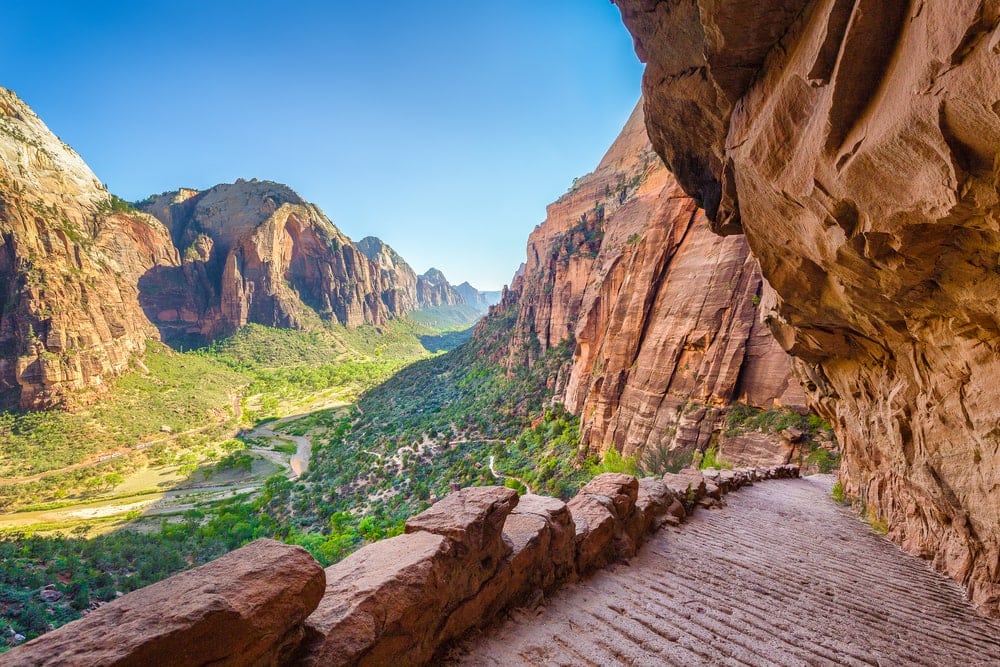
A switchback is a type of path that follows a zig-zag pattern up a steep stretch of terrain such as a hill or mountainside.
Rather than climbing directly up the slope, which would make for an exhausting trek and open the door for any number of potentially dangerous situations, switchbacks run from one side of the slope’s face to the other before reversing course—or “switching back”—and continuing in the opposite direction.
This casual to-and-fro motion makes it far easier for hikers to deal with drastic changes in elevation by breaking them down into shorter, more digestible sections. It also allows them to steer clear of obstacles like dense brush, rock piles, drop-offs, and natural geological elements and waterways that could stall progress on a straighter route.
Switchbacks are more than just a convenient development in trail engineering. They can be a literal lifesaver if you’re hiking somewhere with an extreme gradient and a lack of secure footing.
A Brief History of the Switchback
While we have no definitive historical record of how switchback trails came into being, it’s safe to assume that they’ve probably been in use since humans first began lugging themselves and their possessions over mountains and other arduous terrains.
Early travelers undoubtedly would have learned rather quickly that attempting to walk directly up a near-vertical pitch is simply more trouble than it is worth. Instead, the brighter minds among them would have resorted to scrambling up diagonally, finding that this approach presented them with a more forgiving angle of ascent.
As these experimental byways became more established, their smooth, alternating trajectories would have come in handy for leading carts and pack animals, which likely would have been loaded with hundreds of pounds of food, clothing, tools, or commercial wares. A gentler incline meant an easier journey, better footing, and less risk of losing a valuable animal or precious supplies.
This same trail planning strategy would later be used to devise railway routes all over mountainous regions of the United States and other countries.
In fact, the basic principle of the switchback led to the invention of something known as the gravity railroad, a popular form of conveyance in the 19th and 20th centuries that made it possible to transport people and goods downhill using only downward momentum. Gravity railroads gave passengers such a thrill that they would go on to serve as the inspiration for another major invention you might have heard of— the roller coaster .

Nowadays, switchbacks are a ubiquitous sight on hiking trails and other high-altitude passages. In addition to marking the way to popular outdoor attractions, it’s not unusual to spy them on mountain roads that wind their way up and down areas that might otherwise be too dangerous to traverse via automobile.
Tips for Hiking Switchbacks
Hiking a trail fraught with serpentine switchbacks isn’t all that different from hiking a straight open land path. But there are a few things you should know about them if you want to save yourself some trouble and get the most out of your trip.
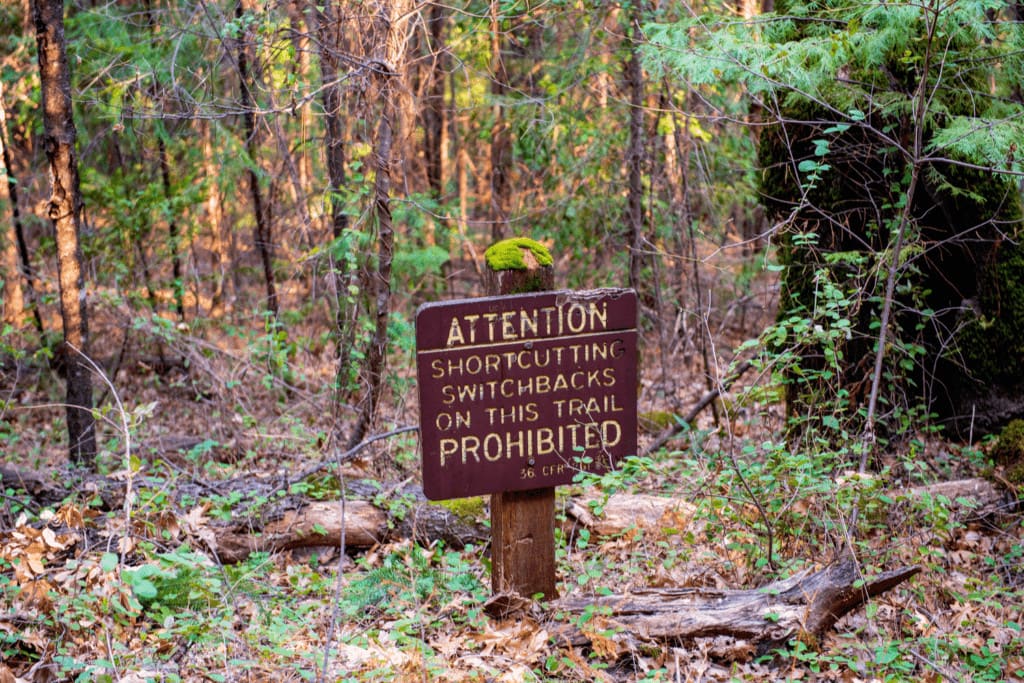
1. Pace Yourself
Switchbacks spare you the labor of tackling hills and ridges head-on. But their expediency comes at a price, which is a considerable increase in the total length of the trail.
Think about it like this: instead of going from Point A to Point B, a trail containing multiple switchbacks will start at Point A and veer over this way, then double back on itself, then 180 again and continue meandering along in this unhurried fashion, at last reaching its endpoint after many dizzying about-faces. It will therefore be much longer than one with few or no deviations.
In other words, you’ll have a lot farther to go than it might initially seem.
With this in mind, it’s best to take your time and avoid rushing through a zig-zagging section of the trail in an effort to reach your destination faster. Not only will this wear you out in no time flat, but it will also deprive you of a chance to drink in the beauty of your surroundings. After all, the real magic of a hike lies in getting there.
2. Don’t Underestimate the Trail
Switchbacks are intended to reduce the overall difficulty of a given trail. By decreasing the grade and stretching it out over a greater distance, they can turn a daunting slog into an enjoyable jaunt, one that allows you to keep up a steady pace without totally obliterating your legs or lungs.
That doesn’t mean they’re a proverbial walk in the park. Not by a long shot.
Switchback trails are often quite steep—in some cases almost as steep as the rises they’re etched into, despite the fact that they extend much further. They also tend to be narrower than open and backcountry trails , with precarious, frequently-unguarded slopes on the downhill edge.
For these and other reasons, it can be a mistake to take a hike lightly just because you see a few unassuming switchbacks on the map. Failure to respect the trail you’re traveling on could set you up for a humbling—or even hazardous—experience.
3. Watch for Trail Markers
Some trails are harder to follow than others, especially if they don’t see much regular foot traffic. This is true of switchbacks, as well.
As you proceed down the path, keep your eyes peeled for signs, reflectors, flags, paint blazes, or other trail markers . The presence of these indicators will confirm that you’re going the right way and keep you from wandering off somewhere you’re not supposed to be.
Depending on your location, getting off course could land you in hot water.
There are the usual perils to watch out for, of course, like getting lost or stumbling across a type of bear , a large predator or unseen trail hazard. But there’s also the risk of disturbing vulnerable wildlife habitats or doing damage to the natural environment in some other way
If you’re worried about getting turned around, take some time to study a map of the trail before you set out. A good trail guide will tell you everything you need to know about the terrain you’ll be up against plus showcase interesting tidbits about the local flora and fauna. A great one will also give you directions to hidden gems like waterfalls, caves, and swimming holes.
4. Be Prepared to Encounter Uneven Terrain
In the best-case scenario, a switchback trail will be more or less flat underfoot. More often than not, however, it will be rocky, root-strewn, and uneven from mile one.
When the road gets rough, remember to take small, careful steps and always check your footing before setting down your full weight . At times you may come upon places where the path is slightly angled, usually towards the lower end of the slope. In these spots, you’ll want to walk with your feet at a corresponding angle to maximize your contact with the ground.
Since this kind of marching can be pretty tough on your ankles after a while, it’s a good idea to strap on a sturdy pair of high-top boots that provide some degree of ankle support. You’ll be glad you did at the day’s end.
Make sure your footwear offers solid traction, as loose rocks and shifting soil are practically guaranteed no matter where you happen to be roving. Hiking poles, while not a necessity, can lend a little extra stability and can be a big help when testing your next step.
5. Never Short-Cut a Switchback
Universal trail etiquette dictates that hikers stick to their chosen trails at all times.
It’s considered bad form to ignore the path that’s clearly laid out for you and go off on your own. Why, you ask? Because this sort of behavior can destroy vegetation and create or worsen soil erosion , which can, in turn, have harmful effects on any type of plant and animal life. This is the last thing we want.
You might occasionally be able to make out a faint footpath running up the middle of a switchback, but these are generally made by either park authorities or scoundrels who break the rules. Either way, you shouldn’t follow their example.
Remember, as lovers of the Great Outdoors, our foremost responsibility is to leave no trace. That means packing out food and trash, yes, but it also means actively taking steps to limit our interference with the course of nature. One such step is to stay on the trail.
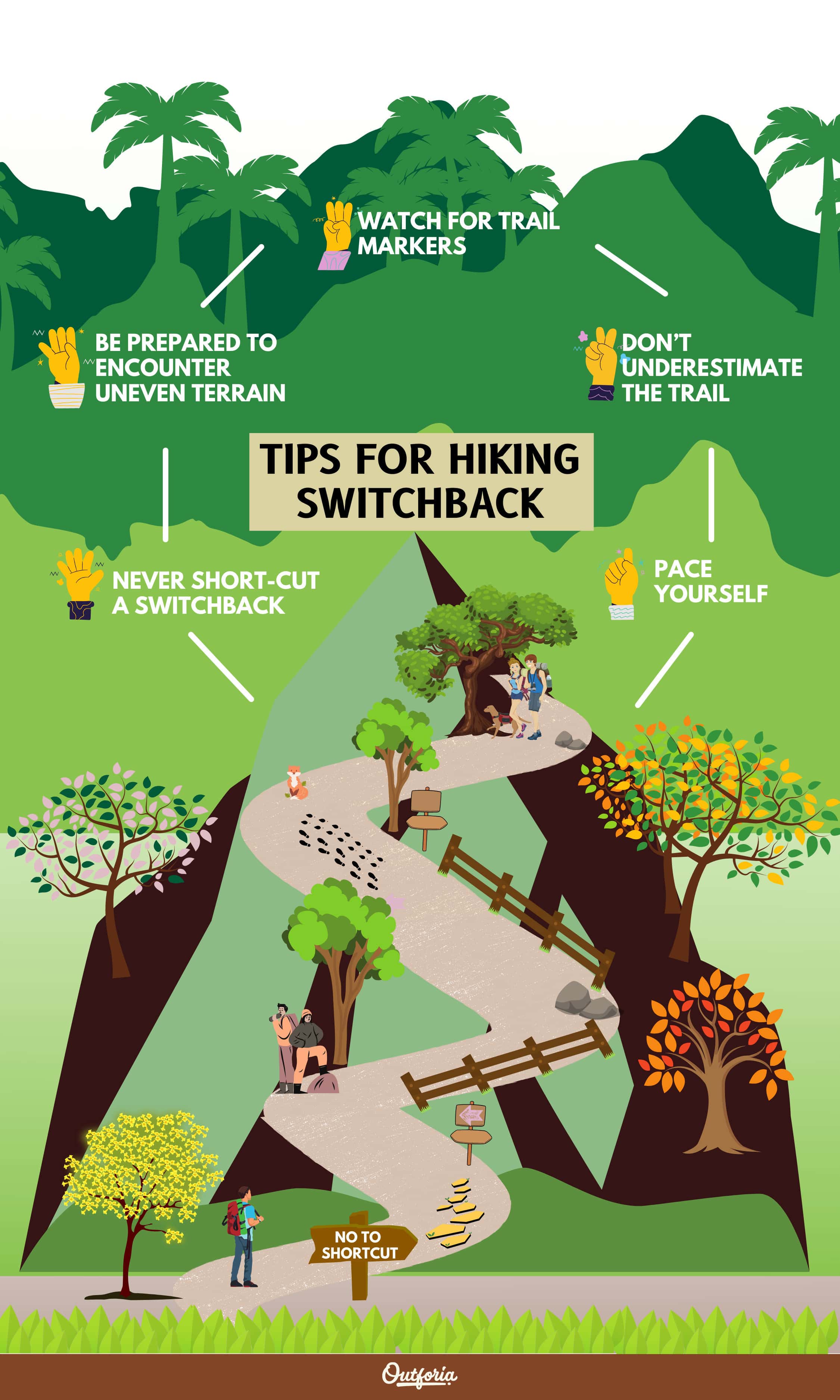
Share This Image On Your Site
You May Also Like: Learn Why You Need Trekking Poles With Complete Guide, Infographics, Pro Tips and more!
Famous Switchback Trails
Looking for a fun yet challenging switchback hike to kick off the season? Try out one of these well-trod favorites. Each offers stunning scenery and lots of tricky directional changes with no special equipment or overnight camping required. What’s more, they’re all located in the good ol’ U-S-of-A:
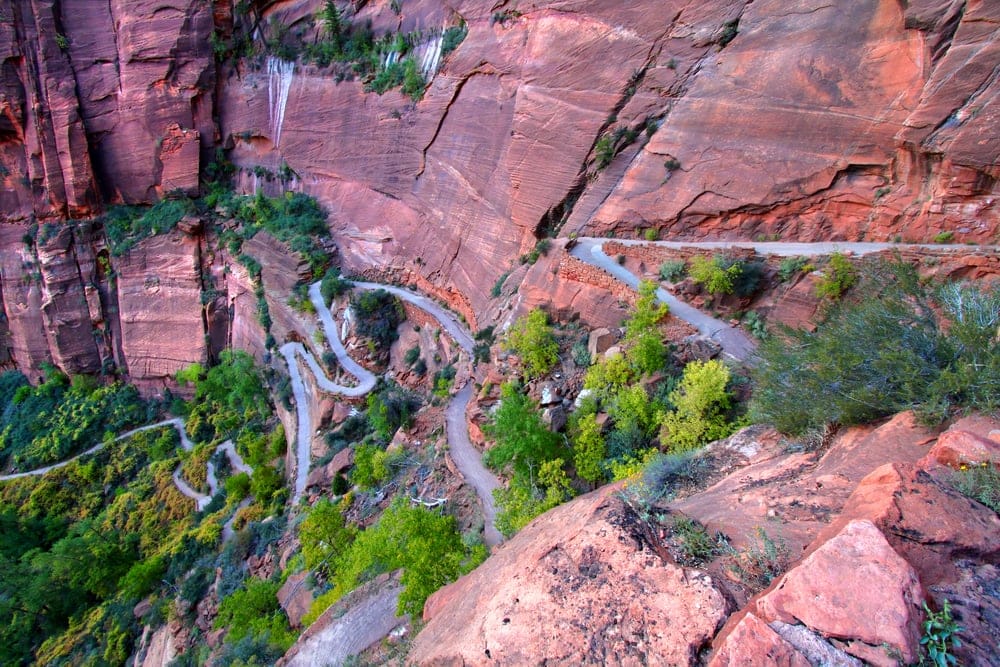
- Angel’s Landing (Zion National Park, Utah)
- Deer Mountain (Tongass National Forest, Alaska)
- Gregory Bald (Great Smoky Mountains National Park, Tennessee)
- Half Dome (Yosemite National Park, California)
- Mount LeConte (Great Smoky Mountains National Park, Tennessee)
- Mount Whitney (Sierra Nevada, California)
- Pololu Valley (Kohala Mountain, Hawai’i)
- Precipice Trail (Acadia National Park, Maine)
- Saddle Peak (Santa Monica Mountains, California)
- Wheeler Peak (Sangre de Cristo Mountains, New Mexico)
Still got questions? Here are answers to some of the most common queries about switchbacks, their uses, and how to hike them safely and successfully.
What is the purpose of switchbacks?
Switchbacks make hiking steep terrain less grueling by decreasing the grade, or incline, of the trail. Since you’re not being forced to charge directly up a hill or mountainside, you can take your time reaching the summit and conserve enough energy to actually appreciate it once you get there.
Trail planners also use switchbacks to preserve control over soil erosion on at-risk slopes, thereby preserving the sanctity of important natural areas. That’s a win-win if you ask me.
What is cutting a switchback?
“Cutting” a switchback refers to the practice of taking a shortcut up a lengthy switchback trail by walking directly up the slope. Like I mentioned previously, this is a big no-no.
Always stay on the trail unless for some reason it’s unsafe to do so, as in the case of a bear sighting or rockslide. Resist the temptation to bypass a switchback by clambering up the slope in the middle or on either side, even if there’s evidence to suggest that others have done it. The trail is there for a reason. Use it.
What is a switchback in mountain biking?
Mountain biking trails are another place you’re likely to come across switchbacks.
These are similar to the kinds of switchbacks you’d find on a typical hiking trail, only with tight hairpin turns that may or may not provide enough space to allow both wheels to follow the same line. Mountain bikers often have to learn special techniques for negotiating switchbacks on their noble steeds.
About Carl Borg
Carl is the founder and strategist of Outforia. Annoyed by the lack of quality online outdoors publications willing to uphold high standards of value and ethics, he decided to make the resource he would have wished to read. Living by the beach in Norway, Carl is never far from outdoor adventure. When not curating Outforia, Carl spends his time kayaking, forest bathing, diving, and camping.
Related Posts

Hiking as a First Date

7 Must-Know Hiking Trail Signs

Food to Take on a Hike: Top 10 Trail Snacks

Walking with Nature: A Guide to 20 Different Types of Hiking

Hiking for Beginners on a Budget

H2No® vs. Gore-Tex®: Which one should you choose?

Hiking Guides
What is a Switchback? Your Guide to Hiking Switchbacks
Published: 16th March 2023
If you’ve been planning a hiking trip, you’ve likely come across the term “ switchback ”.
But what are switchbacks in hiking, and how do you prepare for them?
In this guide we will cover:
- The meaning and history of switchbacks
- What to expect
- Tips for using switchbacks
Let’s get to it!

What is a Switchback?
A switchback is a trail that cuts sharply back on itself in a zigzag pattern. This allows your hike to be less steep and enables you to summit heights that would not be possible otherwise.
Switchbacks have been in use since ancient times, as they allow safer and easier travel up mountain ranges especially when transporting goods. They can be found all over the world, including on Machu Picchu!
The term switchback was popularised by the railroad companies in industrial revolution era America, as this type of rail formation was a necessity for getting large loads of freight up inclines.
It was equally important for getting the empty carts back down without them picking up too much speed.
Using switchbacks in hiking helps you to conserve energy, allowing you to keep going for longer periods of time.
Switchbacks are also beneficial to the natural environment, as they slow down soil erosion by preventing water from flowing straight down a slope.
Switchback vs Direct Hike
While switchbacks could be considered the more leisurely route, when compared to ‘direct hikes’, switchbacks will increase the distance you need to cover over the hike, albeit as a lesser incline.
A direct hike refers to a trail that goes straight up the slope or hillside, without any zigzags or switchbacks.
Direct hikes are generally steeper and more challenging than switchback trails, as hikers must climb directly up the incline rather than gradually zigzagging their way up the slope.
Direct hikes are often used by experienced hikers or mountaineers seeking a more challenging and adventurous ascent.
Basics of Switchbacks in Hiking

Remember to Pace Yourself
It might be tempting to speed up upon reaching a switchback, as the slope is not as steep as a direct hike. However, it’s best to stay steady.
You don’t want your energy level to drop too fast and leave you running on empty for the rest of your trek.
One Turn at a Time
Make sure you stick to the trail. While it might be tempting to cut directly upwards and cut the corner, this will be harder on your body in the long run.
Plus, it’s dangerous, as the off-trail terrain won’t be as packed down and will be steeper. As a result, there is a much greater risk of losing your footing.
Switchbacks are also often planned to protect native flora and fauna, as you don’t know what you might be trampling when you leave the path.
Additionally, hikers forging their own way up or down through the switchbacks can damage the trails themselves– making them more susceptible to washing out after a heavy rain.
Bottom line — take it one turn at a time, both for you and those around you!
Be Mindful of the Trail
Be sure to stay alert and keep an eye out for potential hazards. Depending on your area, these could range from unfriendly plants and animals to rock fall hazards.
However, it’s more likely that these would just be the odd stream crossing or tree branch in your way. Remain focused on your surroundings as you walk through them!
Keep an Eye Out for Trail Markers
So you’re trying to stick to the trail, but sometimes that’s easier said than done.
Occasionally, it may be difficult to tell which way to go due to plant growth, trail washout, or confusing maps. Luckily, your trail will likely be marked to keep you on the right track.
Trail markers vary from place to place, but common iterations include signs with arrows, reflective triangles on trees, bright spray paint marks, and posts.
Make sure to do your research on the hike you plan to take before you start your journey so you know what to look out for.
Prepare for Uneven Terrain
Even the best-maintained switchbacks may have uneven terrain at some points. This includes everything from slope changes to non-uniform ground.
Stay on top of it by preparing in advance with good footwear, equipment, and plenty of water and fuel.
Tips for Switchbacks in Hiking

Improve Your Fitness
Physically preparing yourself will enable you to go further with less effort when it comes time for your hike.
How much preparation you do of course depends on your current fitness level, and how challenging the trail you plan to do is.
Focus on your legs, core, and lower back when training for your adventure.
Related Post: What Muscles Does Hiking Work? A Comprehensive Guide
Some exercises you could do include:
- Weighted lunges
- Weighted step-ups
Wearing the pack you intend to use on your journey will also help your body acclimate to it while getting stronger. You’ve got this!
Use the Right Equipment
Getting the right gear is key to making sure your trip is safe and comfortable.
Precisely what you’ll need varies depending on the location, the duration, and the difficulty of your hike, as well as the expected weather.
For the essentials, it’s often worth spending a little more to ensure quality and durability.
Check product reviews and hiking forums to find the best equipment for your specific tramp.
Make sure to double-check you have everything and test your equipment before you depart.
Practice Switchback Trail Etiquette
As we’ve already covered, never cut the corner of a switchback. Additionally, make sure to clean up after yourself and leave things as you found them.
In protected areas, taking anything other than photographs can be illegal.
As a general rule, stick to the same side of the path as a car would to a road when passing others coming from the opposite direction.
If a passing occurs at a particularly narrow or treacherous portion of the path, it’s polite (and safe) to wait to the side and let the oncomers pass you.
Stay Fueled and Hydrated

Make sure you’ve given your body everything it needs to be running at peak performance for your trip.
Eat before you start your hike, and bring familiar, easy-to-eat, and healthy food with you.
Drink at least two litres of water per day, preferably with added electrolytes. Water should be brought with you in a bottle or water bladder, as clean drinking water may not always be available.
Use Hiking Poles

Hiking poles can be an excellent tool to use on more rigorous switchback trails.
Using poles can help to lessen the strain on your leg muscles on steep inclines, and protect your knees on descents.
Hiking poles also can better your balance on narrow or uneven trails.
Famous Switchback Trails

Angels Landing Trail, Zion National Park, Utah, USA :
This 2.5-mile (4 km) trail is known for its steep switchbacks and incredible views of Zion Canyon. The trail gains 1,488 feet (454 m) in elevation, and the final section of the hike includes a narrow spine with chains to hold onto for safety.
Grinnell Glacier Trail, Glacier National Park, Montana, USA :
This 11-mile (17.7 km) trail is a popular hike that takes hikers up to Grinnell Glacier. The trail includes a series of switchbacks that climb over 1,600 feet (487 m) in elevation, and hikers can enjoy stunning views of the glacier and surrounding peaks.
Half Dome Trail, Yosemite National Park, California, USA :
This 14.2-mile (22.8 km) trail is known for its final section, which includes a set of steep switchbacks leading up to the top of Half Dome. The switchbacks, known as the “cables route,” require hikers to use a cable system to pull themselves up the final 400 feet (122 m) to the summit.
Bright Angel Trail, Grand Canyon National Park, Arizona, USA :
This popular trail descends 4,380 feet (1,335 m) into the Grand Canyon, with a series of switchbacks leading hikers down to the Colorado River. The trail is 9.3 miles (15 km) long and offers incredible views of the canyon’s geology and ecosystems.
Rattlesnake Ledge Trail, Washington, USA :
This 4-mile (6.4 km) trail is located near Seattle and features a series of switchbacks that climb up to a scenic overlook of the Snoqualmie Valley. The trail gains 1,160 feet (353 m) in elevation, and the overlook offers stunning views of the surrounding mountains and forests.
There you have it. Make sure to plan ahead for your switchback adventure, get the right tools and equipment, and be in good shape to thrive on the trails.
Enjoy reaching new heights with greater ease through using switchbacks, and remember to take them one turn at a time!
Share this:

Leave a Reply Cancel reply
Hey, I'm Mitch Taylor , your go-to camping and hiking buddy! With two decades of experience exploring the great outdoors, I'm here to share my tips, tricks, and answer your common questions. This hobby of ours has an entire world for us to explore - so let's do it together. Your adventure starts here!
Is Cedar Good Firewood?
Is elm good firewood your guide to campfire wood, discover more from branch outdoors.
Subscribe now to keep reading and get access to the full archive.
Type your email…
Continue reading
TrekkingLabs.com
What Are Switchbacks In Hiking and How to Use Them Efficiently?
If you’re an avid hiker or someone who enjoys an occasional walk in the woods, you may have heard the term “switchbacks” before. Switchbacks – or zigzag trails – are a series of sharp turns that hikers use to gain elevation gradually.
But why are they necessary? And how can you use them efficiently on your next trek? In this blog, we’ll explore what switchbacks are, why they’re important, and how you can make the most of them.
What Are Switchbacks In Hiking?

Switchbacks are essentially a series of hairpin turns that take you up a steep incline in a more gradual way than if you were to go straight up. They are typically added to a trail where there is a significant climb in elevation, offering hikers a more manageable way to ascend to the top. In addition to making steep climbs easier, switchbacks are used to prevent erosion on trails. By zigzagging up a steep slope, foot traffic is distributed more evenly, reducing the trail’s wear and tear.
In terms of safety, switchbacks also prevent hikers from slipping or losing their balance while hiking uphill. Walking in a straight line up a steep incline can be treacherous, so switchbacks offer a safer option. By breaking up the climb, you’ll be better able to preserve your energy and remain alert and focused.
Switchbacks are also essential in reducing the environmental impact. Without them, hiking trails would be eroded, widened, and destroyed quickly, leading to unpleasant and unsafe experiences. In addition to deteriorating the aesthetics of the trail, erosion can also lead to an increased risk of landslides and other natural disasters.
When you’re hiking on a trail with switchbacks, it’s essential to approach them correctly. Many hikers tend to cut across switchbacks, which can significantly harm vegetation, and in the long term, erosion can affect the trails’ safety. Hiking straight uphill without utilizing switchbacks makes trails steeper, leading to erosion. It can also cause others to follow your lead, which then further intensifies the damage to the trail. So how to use switchbacks efficiently?
To use switchbacks effectively, take your time. Don’t be in a hurry to get to the top. This isn’t a race; it’s a journey. Take breaks when you need to and pace yourself. In contrast, if you speed up and slow down, stopping on the turn and then accelerating on the straight section, you’re not only moving more quickly but also taking advantage of the switchback easing the ascending way uphill.
Another tip to consider is to watch your step. Depending on the incline of the switchback, soil, gravel, and rocks may present themselves in different sizes and shapes, so it’s crucial to watch your step as you travel up and down the switchback. If you find the incline too challenging, take a break to ensure you’re not putting yourself or others at risk of losing their balance.
What Is The Purpose Of A Switchback In Hiking?

1. Erosion Control
One of the primary reasons for switchbacks is to prevent soil erosion. When people hike straight up a steep slope, they create channels for runoff water. Over time, these channels can become deep grooves, washing away soil, and causing the trail to become unstable. By creating sharp turns in the trail, water is forced to disperse over a larger area instead of running down a single channel. This leads to a reduction of soil erosion and less damage to the trail.
2. Trail Maintenance
Switchbacks are the key to maintaining hiking trails in good condition, particularly in heavily-used areas. When hikers descend straight down a hillside, they tend to create a path by cutting off a direct line to the bottom. This causes the trail to become wider and compromise its structural integrity. When switchbacks are in place, you are always decreasing the trail’s gradient, encouraging hikers to use a designed route and preserving the natural environment.
3. Energy Conservation
When you hike straight up a steep hill, your body is forced to use more energy, making the hike more tiring. Switchbacks, on the other hand, spread the elevation gain over a longer distance, reducing the steepness of the incline. This eases the physical stress on hikers, enabling them to conserve energy, and to remain fresher for a more extended period. For this reason, you will find that hiking routes with switchbacks are typically less strenuous and more manageable.
4. Scenic Views
One of the main benefits of hiking along a switchback trail is the ability to take in the stunning views. Because switchbacks follow an ascending path, hikers are exposed to a more extended panoramic vista. It’s also an excellent way to break up the monotony of the hike. The constant elevation change and change in direction keep the hiker’s interest and prevent the journey from feeling too repetitive.
5. Environment Preservation
Switchbacks not only benefit the hiker but also the environment. By following a designed route, the number of hikers wandering off the trail decreases, and the local habitat is not disturbed. The constant trampling of feet and soil erosion caused by hikers can have critical and long-lasting effects on the environment. By using switchbacks, the impact of hiking is minimized, allowing the flora and fauna to thrive.
Why Are They Called Switchback?
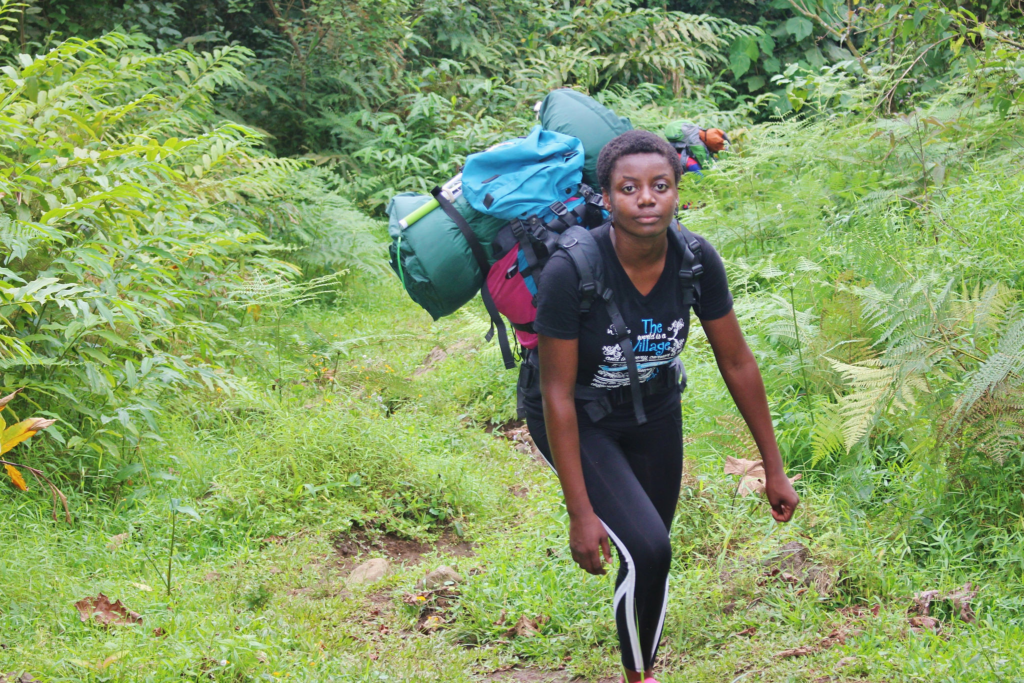
The practice of creating switchbacks on hiking trails dates back centuries. One theory about their name is that it combines two different words. The first being the word “switch,” which was used in the 1700s to describe the act of swinging or turning back and forth. The second word, “back,” refers to the trail’s zigzagging movements as it ascends or descends the mountain.
Apart from their name, switchbacks also have a practical purpose. They’re designed to help conserve energy and stabilize the trail. By zigzagging back and forth, switchbacks reduce the overall incline of the trail, making it easier to climb or descend. They also help to prevent soil erosion and protect the surrounding flora and fauna from human damage.
Switchbacks provide hikers with numerous benefits. They offer a more leisurely and less strenuous way to traverse a steep trail. They also provide panoramic views of the surrounding landscape, so it’s an excellent opportunity to take a break from the climb and enjoy the natural scenery. Switchbacks help prevent soil erosion and help maintain the path, so it’s essential to stick to the designated path.
When planning your hiking trip, you should consider the conditions on the way. The perfect way to prepare yourself for a hilly or mountainous hike that has many switchbacks is to carry a light backpack, wear comfortable hiking shoes, and carry plenty of water to stay hydrated. It’s also recommended that you hike with a partner or group, mainly when tackling steep or challenging trails with lots of switchbacks.
What Is A Switchback On A Mountain Road?
A switchback is a road design used to mitigate the steep inclines and declines in mountainous terrain. In a switchback, the road turns back and forth, zigzagging up and down the mountain by making a higher angled turn than a standard curve to reduce the incline.
You can identify it by the sharp turns and hairpin bends that loop upward over the next part of the hill. Switchbacks can range from two to three turns to complexes of up to eight or more turns, depending on the mountain’s grade and length. Switchbacks make steep slopes manageable for drivers since it reduces the sharp uphill or downhill incline angle.
Switchback designs are usually applied in mountainous, rocky, or hilly terrains, where the ground is unstable, making it challenging to construct a road with a constant elevation.
The road designers create switchbacks to reduce the need for extensive excavation and leveling of the terrain or cutting through the hills. The zig-zagging design of the road can also help control the speed of the vehicle descending a mountain slope, or climbing up an incline.
Riding on mountainous switchback roads can be part of an adrenaline-fueled adventure. However, the road is also more dangerous than the standard flatroad, especially if you are not experienced in such driving.
Switchbacks make it necessary to make slow and careful turns, especially when the curves are very tight. The steepness of the inclines can also make it challenging to brake and decelerate, making the need for cautious and experienced driving crucial. If you are driving for the first time on a switchback mountain road, it is advisable to slow down, use lower gears, and respect the limits.
The switchbacks require good visibility and proper road signs to ensure safety to the drivers and passengers. In egg, switchbacks designed without warning signage can be incredibly dangerous, leading to accidents. The warning signs could help drivers to anticipate every turn and change in the terrain, adjust their speed accordingly, and react to dangerous turns.
Road builders put up guardrails or enclosures to protect road users from accidental barriers, ditches, cliffs, and trees. The switchbacks and the surrounding areas need to be well-maintained to prevent landslides, rockfalls, and other natural hazards that can occur in the location.
5 Tips For Switchbacks In Hiking
Build Your Fitness
Even though switchback trails are less steep than a direct route up the hill, they still pose their own challenges. However, they are a popular choice because they provide certain benefits. By taking switchback trails, you will end up hiking a longer distance, but this gradual ascent can be less taxing on both your cardiovascular system and muscles.
To excel at switchback hiking or even to reach the top without feeling worn out, you need a combination of muscular strength, muscular endurance, and cardiovascular endurance. Therefore, it is crucial to prepare yourself physically before embarking on a switchback hike.
In the weeks leading up to your hike or the hiking season in general, it is recommended that you focus on building your aerobic fitness and muscular strength. Incorporate cardio exercises into your routine such as cycling, running, jumping rope, swimming, or rowing. As your fitness level improves, gradually increase the duration of your workouts.
To specifically prepare for hiking switchbacks, consider adding stair climbing to your routine. Climbing stairs, whether it’s at a stadium, using a StairMaster, or simply going up and down the stairs in your home, is an excellent way to strengthen your glutes, calves, quads, hamstrings, as well as your heart and lungs.
In terms of lower-body strengthening exercises, include step-ups, squats, lunges, deadlifts, bridges, calf raises, and step-downs in your workout routine. These exercises target the muscles necessary for hiking switchback trails and will help you build the required muscular strength.
Don’t forget to also prepare for downhill switchbacks by incorporating downhill lunges into your training regimen. These exercises will help you develop the necessary stability and strength for descending switchback trails effectively.
Use The Right Gear
Switchbacks in hiking can be challenging, but with the right hiking gear, they become much easier and more comfortable to tackle. Hiking boots are essential as they provide support and traction for ascending and descending switchbacks. Additionally, breathable and moisture-wicking hiking socks can prevent blisters.
To further enhance your hiking experience, consider using hiking poles. These not only provide extra support and stability on steep sections of the trail but also help distribute your body weight, alleviating stress on your knees and ankles, especially when navigating downhill switchback trails.
Fuel And Hydrate Well
Hiking switchback trails can be tough and physically demanding. It is important to stay hydrated by drinking plenty of water. Additionally, having nutritious and energy-dense snacks such as nuts, dried fruit, and natural protein bars can help to sustain your energy levels throughout the hike.
Respect Switchback Etiquette
Following proper switchback etiquette won’t just make you look like a veteran hiker even if you’re a beginner, but it is also crucial to preserve the latency of the trail. By following the switchback path as it is and refraining from cutting straight up to the next zig or zag that’s uphill or downhill from wherever you are on the trail, you help prevent soil erosion, protect local vegetation, and maintain the delicate balance of the ecosystem. It’s a responsible choice that ensures the longevity and sustainability of the trail for future hikers to enjoy.
Take It One Turn At A Time
It can be bewildering and debilitating to look at all the seemingly millions of switchbacks up the hillside when you’re at the base. Switchbacks in hiking trails can indeed be time-consuming and tiring, especially if the mountainside is steep because then you’ll be zig-zagging many times over.
However, it’s important to remember that each turn brings you closer to your destination. Instead of feeling overwhelmed, try focusing on one turn at a time and staying present on the path you are currently on. Don’t worry about what lies ahead; just enjoy your surroundings and feel proud of the hard work you’re doing.
Remember, you will eventually reach the top, and when you do, the sense of accomplishment will make it all worthwhile. To help you prepare for your next big hike and reach the summit stronger than ever, we have a 4-day training plan designed to build your strength.
Are There Downsides To Switchbacks In Hiking?
The only real “downside” to switchback trails is that they can be tedious and require a lot more time to hike than a direct route. However, switchback trails offer a number of benefits. They help minimize the steepness of a climb, making it more manageable and less strenuous.
Additionally, switchbacks help prevent erosion on the trail by distributing foot traffic more evenly. Overall, while switchback trails may require more time and effort, they provide a safer and more sustainable hiking experience.
Famous Switchback Trails
Angel’s landing trail.
Located in Zion National Park, Utah, Angel’s Landing Hiking Trail is one of the most daring and thrilling hiking paths in America. The 5.4 miles round-trip trek is a challenging adventure with strenuous switchbacks, narrow pathways, steep cliff drop-offs, and extraordinary views. The trail runs along the Virgin River, through the gorge, and up to the top of the trail with the highest view of the Zion valley.
Skyline Trail
The Skyline Trail has been considered as the best hiking trail in Canada, located in Jasper National Park. The 27.6km trail encompasses rock formations, genuine forests, and an overall sense of beautiful scenery. With its challenging switchbacks and dramatic ascents, the trail allows hikers to witness a variety of Canadian wildlife, including bears, moose, and elk.
Half Dome Trail
Being one of the famous hikes, the Half Dome Trail offers striking and breathtaking views of Yosemite Valley. The switchback trail is 16 miles, known for its elevation gain and especially the last 400 feet which includes holding onto cables while ascending the steep rock face to the top. As challenging as it can be, the trail offers one of the most iconic views in the US.
The Incline Trail
The Incline is just one mile long, but it has over 2,000 steep steps that ascend to an altitude of over 2,000 feet. The Incline is located in Manitou Springs, near Colorado Springs. The trail used to complement a historic railway system used for carrying equipment and building materials up to Pikes Peak, but it’s now a popular attraction for hikers. Hikers enjoy the challenge of the steep incline, which offers a great training ground for every outdoor enthusiast, from novice hikers to experienced climbers.
Mt. Washington Tuckerman Ravine Trail
This switchback trail is one of the most lawfully challenging hiking trails in America, situated in the White Mountains of New Hampshire. Tuckerman Ravine draws in scores of skiers in the winter, but in the summer, the switchbacks offer exhilarating hiking experiences. With a trail distance of 4.2 miles each way, and almost a mile height difference, it’s a strenuous trail. Hikers can enjoy stunning views of the snowfield and the ravine.
Final Thoughts
Switchbacks are a vital tool for maintaining sustainable and safe hiking trails and navigating steep terrain safely. We hope that this brief guide has helped you understand what they are, why they’re important, and how to navigate them effectively.
Next time you hit the trail, remember to practice proper trail etiquette, and, when hiking on switchbacks – be alert to your surroundings. Remember, by keeping to trails and utilizing switchbacks, we are helping to preserve the natural beauty of hiking trails for generations to come.

What is a Switchback in Hiking
Switchbacks are a common feature found in hiking trails that traverse steep or mountainous terrains. They are designed to mitigate the challenges posed by steep inclines by incorporating a zigzag pattern into the trail. In hiking terms, a switchback refers to a sharp bend or turn in a trail that moves in a back-and-forth manner, gradually ascending or descending the slope. Switchbacks are essential in hiking trails due to their numerous benefits. They help reduce the steepness of the trail and the overall elevation gain, making it easier and safer for hikers to navigate challenging terrains. Switchbacks play a crucial role in mitigating soil erosion and preserving the sustainability of the trail. Constructing switchbacks involves a meticulous process that includes planning the layout, cutting into the slope, and constructing sturdy surfaces using a variety of materials such as rocks, logs, or gravel. This ensures stability and durability, allowing hikers to safely traverse the trail. In terms of technique, proper foot placement and balance are vital when hiking switchbacks. Hikers should also consider using trekking poles to provide additional stability and assist with the ascent or descent. Understanding and adhering to trail etiquette is equally important to promote safety and preserve the trail for future hikers. When hiking switchbacks, it is advisable to take your time and proceed at a comfortable pace. Staying hydrated and energized through proper hydration and nutrition is crucial for maintaining stamina and endurance. Techniques such as rest steps and controlled breathing can help conserve energy and prevent exhaustion. Wearing appropriate gear, including sturdy hiking boots and clothing suitable for the weather conditions, ensures comfort and safety while on the trail. By understanding switchbacks and employing proper techniques and precautions, hikers can navigate steep terrains with confidence, enjoy the beauty of the trail, and have a safe and enjoyable hiking experience.
Key takeaway:
- Switchbacks reduce steepness and elevation gain: Switchbacks in hiking trails help reduce the steepness of the ascent and the overall elevation gain, making it easier for hikers to climb.
- Switchbacks mitigate soil erosion: By zigzagging up the trail, switchbacks help prevent soil erosion caused by water runoff, preserving the trail’s stability and longevity.
- Switchbacks promote trail sustainability: The use of switchbacks in hiking trails helps preserve the natural environment by reducing the impact on plant life and maintaining the integrity of the trail system.
What are Switchbacks?
Switchbacks, also known as zigzagging trails, are commonly found on hiking trails, especially in mountainous regions. These trails serve the purpose of allowing hikers to navigate steep slopes in a more gradual and manageable manner. One of the primary advantages of switchbacks is their contribution to safety. By cutting back and forth across the slope, switchbacks minimize the risk of slips and falls on challenging terrains. They create a less steep incline, providing hikers with stable footing. If you want to understand more about hiking terms, you can learn about what does out and back mean in hiking . Switchbacks also play a crucial role in minimizing erosion on the trail. When hikers take a direct path up or down a hill, it creates a direct route for water to flow, leading to soil erosion and trail degradation. By using switchbacks, the water is forced to take a longer and slower route, reducing its impact on the trail. Another significant benefit of switchbacks is their ability to conserve hikers’ energy. Rather than facing a steep incline directly, switchbacks break it up into smaller, more manageable sections. This allows hikers to maintain a steady pace and avoid exhaustion. When encountering switchbacks during a hike, it is essential to stay on the designated trail and avoid cutting corners. Cutting across switchbacks can result in erosion and damage to the trail. It is important to always yield to uphill hikers, granting them the right of way. For optimal hiking experience on switchbacks, it is recommended to take short, deliberate steps and utilize trekking poles for added stability. This approach helps maintain balance and reduces strain on the knees and ankles.
Definition of Switchbacks in Hiking
Switchbacks are sharp turns or zigzag patterns in hiking trails used to manage steep slopes and prevent erosion. They distribute elevation gain over a longer distance, making the trail more accessible. By redirecting water flow, switchbacks minimize erosion. They also preserve trail sustainability by distributing foot traffic and preventing trail degradation. Switchbacks provide a safer and more enjoyable hiking experience. The definition of switchbacks in hiking refers to the sharp turns or zigzag patterns used on trails to manage steep terrain and prevent erosion. They help distribute elevation gain, making the trail more accessible and minimizing erosion by redirecting water flow. Switchbacks also play a crucial role in preserving trail sustainability by distributing foot traffic and preventing trail degradation, ensuring a safer and more enjoyable hiking experience.
Why are Switchbacks Used in Hiking Trails?
Switchbacks are used in hiking trails for several reasons. One of the main purposes is to reduce the steepness and elevation gain, thus making the trail more manageable for hikers. By incorporating switchbacks into the trail, it helps to mitigate soil erosion. This is achieved by distributing the impact of foot traffic and promoting better water drainage, which in turn preserves the trail’s integrity and the surrounding ecosystem. In addition to these benefits, switchbacks are also crucial for the long-term sustainability of hiking trails. They prevent trail widening and environmental damage, while maintaining the natural beauty and scenic views of the hiking area. The construction of switchbacks requires careful planning and building each turn in the trail. Sturdy materials like rocks, gravel, or timber are used to create durable pathways that can withstand heavy foot traffic and varying weather conditions. Hikers should use proper technique when navigating switchbacks . It is important to focus on foot placement, balance, and can use trekking poles for additional support. It is important for hikers to understand and respect trail etiquette, including yielding to other hikers when necessary. When hiking switchbacks , it is crucial to take your time and not rush. Hiking at a comfortable pace allows for better enjoyment of the surroundings and reduces the risk of accidents. Staying hydrated and energized is essential for maintaining stamina during the hike. Rest steps and controlled breathing techniques can also help manage fatigue. It is recommended to wear appropriate gear, such as sturdy hiking boots and comfortable clothing, to ensure a more comfortable and enjoyable hiking experience.
Benefits of Switchbacks
Switchbacks in hiking offer numerous benefits that enhance the overall hiking experience. From reducing steepness and elevation gain to mitigating soil erosion and preserving trail sustainability, these winding trails provide hikers with improved safety, efficient navigation, and minimized impact on the environment . Discover how switchbacks not only make challenging terrains more manageable but also contribute to the long-term preservation of hiking trails and the surrounding ecosystem. Get ready to explore the advantages that switchbacks bring to the world of hiking.
Reduced Steepness and Elevation Gain
Switchbacks in hiking help to reduce steepness and elevation gain on trails, making them more manageable for hikers. Incorporating switchbacks offers several key benefits to hikers: – Reduced Strain on the Body: Instead of tackling steep sections all at once, switchbacks distribute the uphill climb over a longer distance. This helps to reduce strain on leg muscles and makes the ascent easier. – Improved Breathing: Steep trails can often lead to rapid and shallow breathing. By incorporating switchbacks, the elevation gain becomes more gradual, allowing for a steadier breathing pattern. – Decreased Fatigue: Climbing a steep trail with significant elevation gain can be exhausting. Switchbacks break the ascent into smaller, more manageable sections, helping to reduce fatigue and maintain a steady pace. – Enhanced Safety: Steep trails, particularly during descents, can be challenging and potentially dangerous. With the use of switchbacks, hikers enjoy better stability and footing, providing a safer alternative. – Preservation of the Environment: Steep trails are more prone to erosion. By incorporating switchbacks, the amount of water runoff is minimized, reducing erosion and preserving the natural landscape. Incorporating switchbacks into hiking trails ensures that they are more accessible and enjoyable for hikers of all skill levels. It not only reduces steepness and elevation gain but also promotes a safe and sustainable outdoor experience.
Mitigation of Soil Erosion
Switchbacks are an essential tool for the mitigation of soil erosion in hiking trails. They serve multiple purposes, including reducing the force exerted on the ground, promoting effective water drainage, and preserving trail sustainability. By incorporating switchbacks, hikers can enjoy outdoor activities while minimizing their impact on the environment. Switchbacks effectively mitigate soil erosion by allowing hikers to traverse steep slopes gradually. This gradual traversal reduces the force and pressure on the soil, preventing erosion. Instead of directly traversing steep slopes, hikers can follow the zigzag path of the switchbacks , which significantly reduces the risk of soil erosion. In addition to mitigating soil erosion, switchbacks also play a crucial role in promoting effective water drainage. As hikers hike along the switchbacks , rainwater can naturally flow down the slopes, reducing the risk of water accumulation and erosion. This further protects the trails from erosion damage caused by excessive water. By guiding hikers along a designated path, switchbacks prevent trail widening and damage to vegetation. When hikers continuously walk in a straight line up or down a slope, the trail widens and vegetation gets destroyed. By following the switchbacks , hikers are directed along a specific path that minimizes their impact on vegetation and maintains the integrity of the trail. Incorporating switchbacks is crucial for the mitigation of soil erosion in hiking trails. By following the zigzag path provided by switchbacks , hikers can enjoy their outdoor adventures while actively preserving the environment and ensuring trail sustainability for future generations.
Preservation of Trail Sustainability
The preservation of trail sustainability is achieved by incorporating switchbacks , which reduce steepness and elevation gain. This not only distributes weight evenly but also minimizes soil erosion and degradation of the trail surface. Switchbacks play a crucial role in mitigating soil erosion by minimizing water flow down the trail. This preventive measure helps preserve the trail and its surrounding ecosystem. By allowing for a gradual ascent, switchbacks prevent excessive foot traffic and promote vegetation growth. This ensures that the vegetation can recover and thrive in the long run. In order to ensure long-term trail usability, it is essential to incorporate switchbacks . By preserving the sustainability of the trail, erosion and environmental impact can be reduced for future generations to enjoy. Switchbacks are a valuable tool in protecting wildlife habitats as they minimize disturbance along the trail. This preservation helps maintain the homes of various wildlife species and contributes to the overall sustainability of the trail.
How are Switchbacks Constructed?
When it comes to hiking, one crucial element to consider is the construction of switchbacks . These cleverly engineered paths carve through steep terrain, making uphill ascents more manageable. In this section, we’ll dive into the intricacies of switchback construction. From the meticulous process involved in building them to the materials selected for their durability, we’ll uncover the secrets behind these essential trail features. So, let’s lace up our boots and explore the world of switchbacks in hiking!
The Process of Building a Switchback
The process of building a switchback involves several steps to ensure a safe and sustainable trail: 1. Survey the area: Survey the terrain to determine the trail’s path. Assess the slope, vegetation, and land conditions. 2. Plan the layout: Develop a layout plan after completing the survey. Determine the number, width, length, and overall alignment of the switchbacks. 3. Clear the trail: Remove vegetation and obstacles that obstruct the trail’s path, such as rocks, fallen trees, and debris. 4. Cut the trail: Dig into the hillside following the planned layout to create a level surface for hikers. 5. Build retaining walls: Construct retaining walls in steep sections to prevent soil erosion and maintain trail integrity. Use materials like rocks, logs, or concrete blocks. 6. Install drainage features: Install drainage features like culverts, ditches, or water bars to prevent water accumulation and erosion. 7. Surface the trail: Use gravel, crushed stone, or compacted soil to provide a stable and durable walking surface for hikers. Pro-tip: Regular maintenance and monitoring of switchback trails are crucial to ensure their safety and sustainability. This includes periodic inspections, repairs, and clearing of any obstructions or erosion that may arise.
Materials Used in Constructing Switchbacks
Switchbacks are crucial elements in hiking trail design as they provide stability, durability, and sustainability . These switchbacks are constructed using various materials, including gravel, rocks/boulders, timber, natural vegetation, geotextiles, and drainage systems . Gravel is utilized in constructing switchbacks to ensure stability, support, erosion prevention, and durability . Rocks and boulders play a vital role in switchback construction by creating steps and retaining walls that control soil movement and maintain trail alignment. Timber , such as logs or wood boards, is often employed in building switchbacks to provide stability and prevent erosion. It is used to construct steps, bridges, and retaining structures. Natural vegetation , including plants, shrubs, or grass, is also incorporated in switchback construction. It stabilizes the soil, prevents erosion, enhances the aesthetics of the trail, and holds the trail surface. Geotextiles , which are permeable fabrics, are used in switchback construction to improve soil stability, control erosion, and promote vegetation growth. These fabrics are generally placed under gravel or soil layers to provide additional support. Furthermore, drainage systems such as culverts, gravel trenches, or rock-lined ditches, are vital components of switchback construction. They effectively manage water flow and prevent trail damage caused by excessive water accumulation.
Proper Technique for Hiking Switchbacks
Mastering the art of hiking switchbacks requires more than just stamina it’s all about finding the perfect balance. In this section, we’ll dive into the proper techniques that can significantly enhance your switchback prowess. From understanding trail etiquette to optimizing foot placement and balance, as well as harnessing the power of trekking poles, we’ll equip you with all the tools you need to conquer those winding pathways with finesse.
Foot Placement and Balance
Proper foot placement and balance are essential for stability and reducing the risk of injury when hiking switchbacks. Take note of these important points:
- Step deliberately: Firmly place your feet on the trail with intention to ensure a solid footing and prevent slipping or tripping.
- Maintain alignment: Keep your body aligned with the trail and point your feet forward to evenly distribute weight and maintain balance .
- Use smaller steps: Take smaller steps when hiking uphill on switchbacks to maintain balance , prevent fatigue, and adjust foot placement on uneven terrain.
- Engage your core: Keep your core muscles engaged to provide stability and support while navigating switchbacks, especially on steep or challenging sections.
- Choose secure footholds : Look for stable and level areas on the trail to place your feet, avoiding loose rocks, roots, or other obstacles that may cause loss of balance .
- Stay aware of surroundings: Pay attention to trail conditions, terrain changes, and potential hazards to adjust foot placement and make informed decisions.
By practicing proper foot placement and balance , you can navigate switchbacks more confidently and enjoy a safer hiking experience.
Using Trekking Poles
Using trekking poles while hiking switchbacks enhances your hiking experience by providing stability, balance, and reducing strain on your legs. Here are some benefits and tips for using trekking poles:
- Improved stability: Utilizing trekking poles serves as additional points of contact with the ground, thereby increasing stability and balance while hiking switchbacks. They evenly distribute your weight and decrease the likelihood of slipping or tripping on uneven terrain.
- Reduced leg strain: Trekking poles aid in transferring weight from your legs to your arms when ascending or descending switchbacks. This relieves pressure on your knees, ankles, and hips, minimizing the risk of fatigue and injury.
- Increased power and speed: By leveraging your arms and trekking poles to propel yourself, you can enhance power and speed while hiking switchbacks. This enables you to maintain a consistent pace and reach your destination more efficiently.
- Improved endurance: Incorporating trekking poles engages your upper body muscles, conserving energy. This is particularly advantageous during lengthy hikes or when carrying a backpack, enabling you to hike for a longer duration without experiencing fatigue.
To maximize the benefits of using trekking poles while hiking switchbacks, follow these tips:
- Adjust your poles: Ensure your trekking poles are properly adjusted to your height. The ideal length is when your elbows bend at a 90-degree angle when holding the poles.
- Use the wrist straps: Securely place your hands through the wrist straps and adjust them to fit snugly. This allows you to maintain a strong grip on the poles without continuously squeezing them throughout the hike.
- Proper technique: As you hike uphill or downhill, plant your poles slightly ahead and to the side. Use your arms to exert downward force and propel yourself forward, taking small steps to maintain balance.
- Be considerate: When utilizing trekking poles on switchbacks, be mindful of other hikers. Yield the right of way to uphill hikers and uphold proper trail etiquette.
Using trekking poles effectively enhances your hiking experience while navigating switchbacks, making your journey more enjoyable and comfortable.
Understanding Trail Etiquette
Hiking switchbacks requires understanding trail etiquette for a safe and enjoyable experience. Consider the following:
- Be aware of right-of-way: Yield to uphill hikers on the trail. Uphill hikers have the right of way due to momentum.
- Stay on the trail: To preserve the environment and minimize erosion, stick to the designated trail.
- Minimize noise: Keep conversations at a considerate volume to avoid disturbing other hikers and wildlife.
- Passing etiquette: Clearly communicate your intention to pass another hiker. Ask politely and give enough space.
- Pack it in, pack it out: Dispose of waste properly by carrying it out with you.
- Respect wildlife: Observe animals from a safe distance without disrupting their behavior.
- Be courteous to fellow hikers: Share the trail, offer assistance, and be friendly to others.
Tips for Hiking Switchbacks
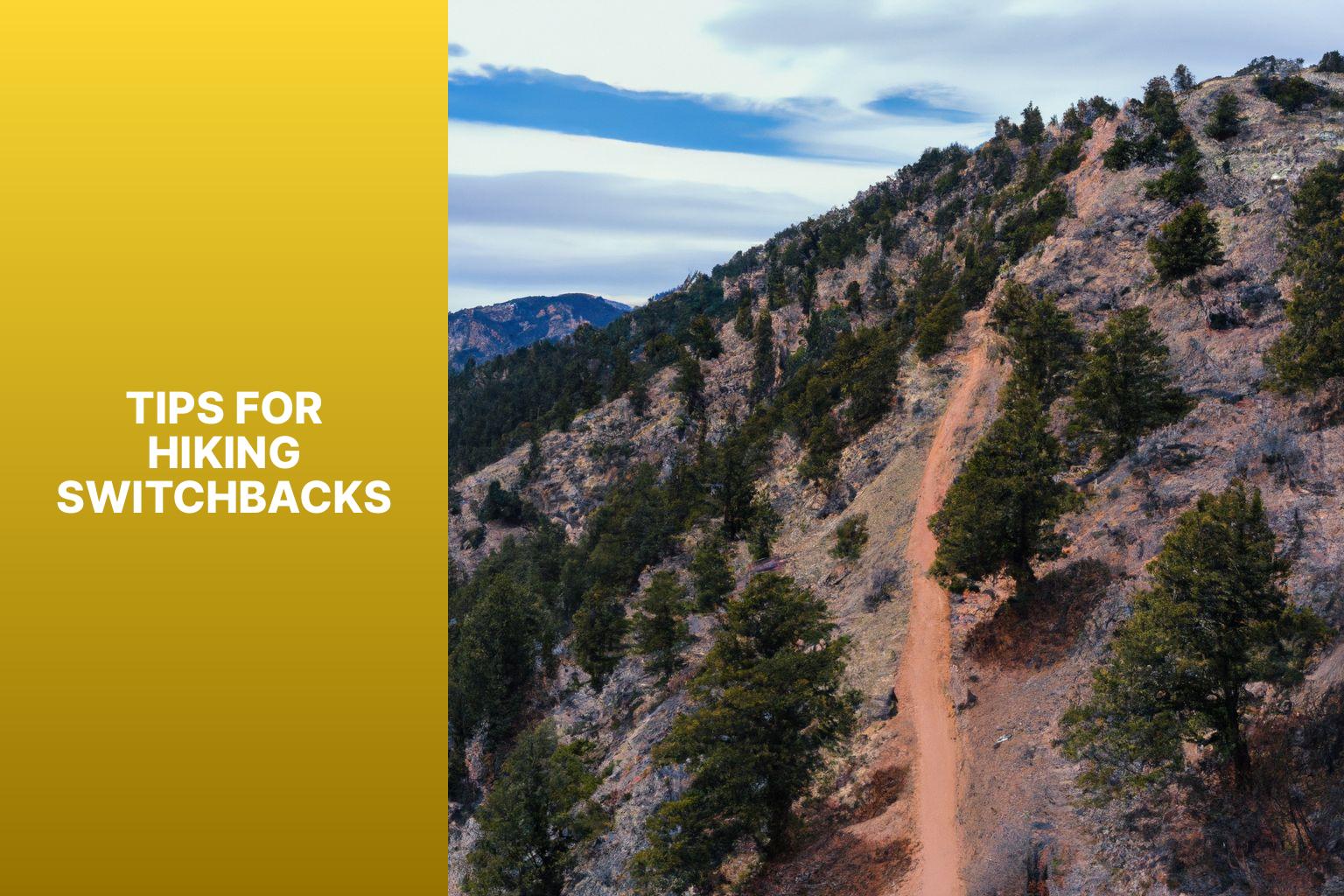
Photo Credits: Jasonexplorer.Com by Thomas Mitchell
Hiking switchbacks can be challenging, but fear not, as we’ve got the ultimate tips to conquer them like a pro! From taking your time to using rest steps and controlled breathing , this section is packed with practical advice to make your switchback experience a breeze. Don’t forget to stay hydrated and energized along the way, and gear up with the right equipment. Get ready to hit those switchbacks with confidence and enjoy the journey to its fullest!
Take Your Time
When hiking switchbacks, it is crucial to take your time and move at a comfortable pace. Rushing through the trail can result in fatigue and an increased risk of injury. By maintaining a steady and unhurried rhythm, you can fully enjoy the breathtaking scenery surrounding you. Taking your time allows you to truly connect with and appreciate nature . It grants you the opportunity to indulge in the mesmerizing sights , enchanting sounds , and invigorating fragrances of the trail. Slowing down enables you to completely immerse yourself in the remarkable hiking experience, regardless of whether you find yourself surrounded by majestic trees or towering mountains . Taking your time during switchbacks conserves your precious energy. By pacing yourself and avoiding excessive physical strain, you retain your stamina for the entirety of the hike. This becomes especially vital on lengthy or demanding trails where endurance plays a pivotal role. Always bear in mind that hiking is not a competition but rather a personal journey. It is about cherishing every moment along the way, not exclusively reaching the destination. So, make sure to take your time, attentively listen to your body, and truly relish the adventure. By doing so, you will not only ensure a safer hiking experience but also enhance its overall enjoyment . Fun fact: Switchbacks are commonly utilized in trail construction to minimize the impact on the environment and diminish erosion. The zigzagging pattern employed while ascending steep slopes aids in evenly distributing foot traffic and preventing the degradation of the trail.
Stay Hydrated and Energized
Staying hydrated and energized is crucial when hiking switchbacks. Stay hydrated and energized with these tips to help maintain energy levels and hydration throughout the hike:
- Drink plenty of water: Stay hydrated and energized by drinking water regularly, especially on steep switchbacks. Aim for at least 8-10 ounces of water per hour.
- Bring electrolyte-rich beverages: Along with water, replenish lost electrolytes from sweat to stay hydrated and energized. Consider carrying sports drinks or electrolyte mixes to maintain electrolyte balance.
- Snack on energy-rich foods: Stay hydrated and energized by eating snacks high in carbohydrates and protein for sustained energy. Pack portable snacks like energy bars, nuts, dried fruits, or trail mix.
- Take breaks: Stay hydrated and energized by scheduling regular breaks to rest and refuel. Use these breaks to drink water and have a small snack to maintain energy levels.
- Avoid sugary drinks and caffeine: Stay hydrated and energized by sticking to water and electrolyte beverages for sustained energy. Sugary drinks and caffeine may provide an immediate energy boost but can lead to a crash later on.
- Listen to your body: Stay hydrated and energized by paying attention to thirst and hunger signals. Drink water and eat snacks when you start to feel thirsty or hungry. Don’t wait until you’re completely exhausted or dehydrated.
- Carry a hydration pack or water bottle: Stay hydrated and energized by having a convenient and accessible water source for easy hydration. Choose a lightweight hydration pack or sturdy water bottle that can be easily refilled.
By following these tips, you can ensure that you stay hydrated and energized during your hike on switchbacks. Take care of your body and listen to its needs for an optimal hiking experience.
Use Rest Steps and Controlled Breathing
Rest steps and controlled breathing are crucial techniques for hiking switchbacks. Incorporating these methods can be incredibly beneficial for hikers as they allow for better energy management and fatigue control. To effectively utilize rest steps and controlled breathing, follow these steps: 1. Make sure to take regular rest steps: It is essential to take breaks after a specific number of steps. This allows your muscles to recover and prevents excessive fatigue. Resting every 15-20 steps or whenever you feel the need to catch your breath is recommended. 2. Focus on controlling your breathing: Practicing deep and steady breathing helps regulate your heart rate and provides more oxygen to your muscles. Remember to inhale through your nose, exhale through your mouth, and concentrate on slow and deliberate breaths to maintain a consistent rhythm. 3. Find a comfortable hiking pace: Adjust your hiking speed to a sustainable pace. Avoid the temptation to rush uphill or downhill as it can quickly drain your energy. If necessary, slow down to maintain endurance. 4. Stay properly hydrated: Hydration is vital during switchback hiking. Make sure to drink water regularly to replenish the fluids lost through sweat. Dehydration can have a negative impact on performance and increase fatigue levels. 5. Listen to your body’s signals: Pay close attention to any signs of fatigue or exhaustion. Take additional rest steps or longer breaks as required. Pushing yourself too hard can lead to muscle strain or even injury. Pro-tip: Incorporating short stretches or gentle movements during rest steps can help minimize muscle stiffness. Stretching improves circulation and reduces the risk of cramps. By incorporating rest steps and controlled breathing into your hiking routine, you can enhance your stamina, improve endurance, and fully enjoy the switchback hiking experience.
Appropriate Gear for Hiking Switchbacks
When hiking switchbacks, it’s crucial to have the appropriate gear for a safe and enjoyable experience. Here is a comprehensive list of gear suitable for hiking switchbacks:
- Hiking Shoes or Boots: It is vital to choose footwear that offers ankle support and has a good grip on various terrains. Look for shoes with sturdy soles and waterproof materials.
- Trekking Poles: These valuable tools are essential for navigating switchbacks. They not only help with balance but also reduce strain on joints and provide stability on steep inclines and descents.
- Backpack: Opt for a lightweight and well-fitting backpack that allows you to carry your essentials comfortably. Ensure it has enough capacity for water, snacks, a map, sunscreen, and other necessary items.
- Water Bottle and Hydration System: It is crucial to stay hydrated while hiking switchbacks. Carry a refillable water bottle or a hydration system with a bladder for convenient hands-free drinking.
- Layered Clothing: Wear moisture-wicking and breathable clothing that can adapt to changing weather conditions. Layering your clothes enables you to regulate your body temperature as you ascend or descend switchbacks.
- Hat and Sunglasses: Protect yourself from the sun’s rays by wearing a hat to provide shade and sunglasses with UV protection to prevent sunburn and protect your eyes.
- Sunscreen and Insect Repellent: Apply a high SPF sunscreen to protect your skin from harmful UV rays. Bring insect repellent to ward off bugs along the trail.
- First Aid Kit: Always carry a basic first aid kit containing band-aids, adhesive tape, antiseptic wipes, pain relievers, and any necessary personal medications.
Remember to check the weather forecast before heading out and be prepared for any unforeseen circumstances. Choose your gear based on the specific trail requirements and your hiking expertise.
Frequently Asked Questions
What is a switchback in hiking.
A switchback in hiking refers to a trail that makes nearly 180-degree turns, cutting sharply from one direction to the opposite one as it goes up a steep hill or mountainside. This type of trail allows for a more gradual climb or descent, making it easier on hikers’ joints. Switchbacks are characterized by hairpin turns and are always carved into hillsides.
How do switchbacks make hiking safer?
Switchbacks make hiking safer by providing a gradual gradation of elevation, which helps hikers avoid hazards like loose rocks and drop-offs. Switchbacks are designed to prevent hikers from falling off due to loose soil, ensuring their safety on steep slopes.
What is the purpose of switchbacks in hiking?
Switchbacks serve several purposes in hiking. They make it easier and safer for hikers to ascend or descend steep slopes, prevent erosion and trail damage, and protect vegetation and wildlife habitat. They also optimize uphill hikes by reducing the incline and providing more time to enjoy the hike.
How should hikers prepare for a switchback hike?
Preparing for a switchback hike involves physical preparation, such as engaging in cardio exercises like stair climbing and lower-body strengthening exercises. Hikers should also have the right gear, including hiking shoes, hiking poles, and comfortable clothing. Staying hydrated and fueling the body with nutritious snacks during the hike is essential.
Why is switchback etiquette important?
Switchback etiquette is important because it helps protect the ecosystem and prevent erosion. By staying on the designated path and not cutting across switchbacks, hikers can preserve plant life, avoid disturbing animals, and maintain the terrain integrity of the trail.
What are some famous examples of switchback trails around the world?
Jason is a seasoned explorer and avid hiker, having traversed hundreds of trails worldwide. His blog is a testament to his passion, offering readers detailed guides, tips, and personal tales from his hiking experiences. His aim is to inspire and equip all hikers, beginners to experienced, for their adventures. So, lace up your boots and join him in exploring the beauty of the great outdoors!
Similar Posts

How Long is Trails From Zero

Why Do People Like Hiking
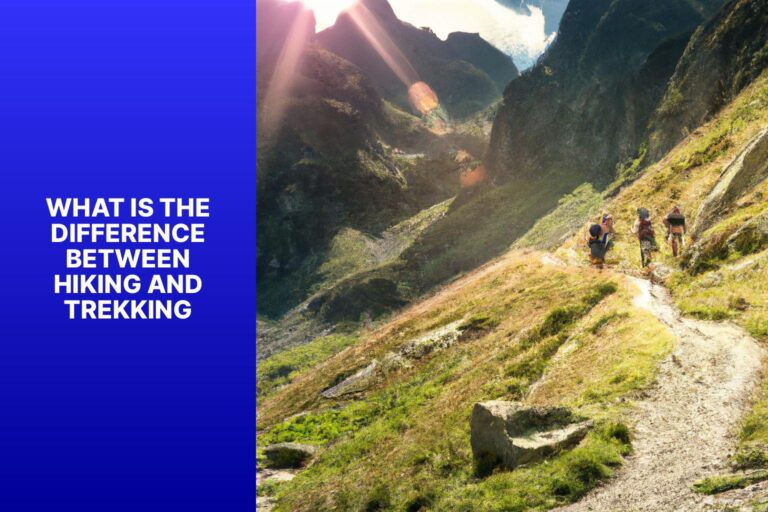
What is the Difference Between Hiking and Trekking

What is a Shakedown Hike
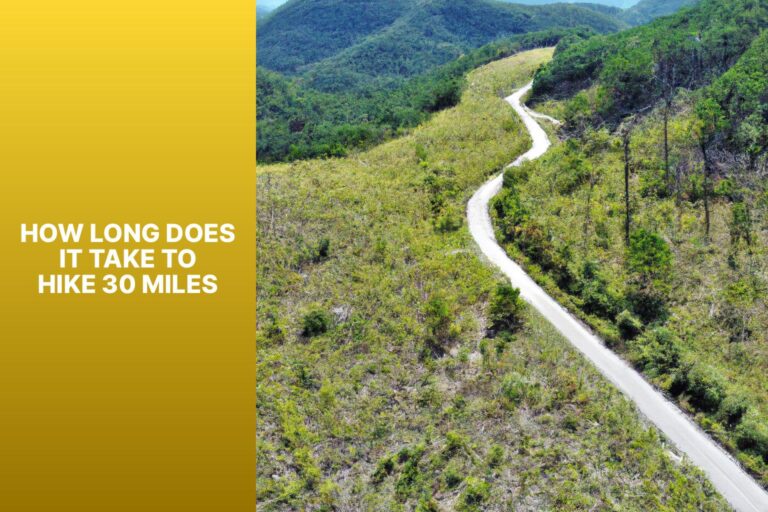
How Long Does It Take to Hike 30 Miles

How Long Does It Take to Hike a Mile

COMMENTS
Travel Up the Switchbacks. Press to activate your Charmed Compass. This will reveal a golden wisp trail that you can follow to your destination. Once reached, prepare for an enemy encounter. Defeat All the Enemies. Now clear the area. Continue Up the Mountain. Loot the area and then press again to reveal the path. Shortly before your ...
Travel Up the Switchbacks Hogwarts Legacy. How to do Travel Up the Switchbacks Hogwarts Legacy quest. You can complete Hogwarts Legacy Travel Up the Switchba...
Travel up the switchbacks. After you finish speaking with Sebastian, you'll need to head southwest, following the path up the mountain. Where the path bends you'll find a small group of goblins. You can easily sneak past them, take them out while stealthed, or just blast them — whatever you prefer. Continue up the mountain, now heading ...
2. Travel Up the Switchbacks. Follow the winding trail up the mountain and into the cavern, until you arrive at a goblin camp. 3. Defeat All the Enemies. Clear the camp and open the Chest inside the tent for a Disarming II trait. 4. Continue Up the Mountain. Head southeast, up the path going into the cavern.
Travel up the switchbacks. Follow Sebastian up-hill and defeat Ranrok loyalists along the way. You can utilize stealth - the enemies are placed in such a way that you can eliminate them silently with ease. Defeat all enemies. Eventually, you'll reach a larger camp that is full of enemies.
Travel Up the Switchbacks. Screenshot via The Nerd Stash (Hogwarts Legacy) Follow the path that leads up the mountain and directly into an enemy camp. Once you're there, Sebastian won't be able to control himself and will charge into the battle, leaving you to follow suit. Defeat All Enemies
"The entrance to the caverns is at the top of the switchbacks leading up the mountain. Sebastian saw a large number of Ranrok's Loyalists guarding the pass. We'll need to be careful." Travel up the switchbacks "We're going to need to get past all these goblins to reach the entrance to the cavern. Sebastian seems to be relishing the fight."
Objective: Travel up the switchbacks From Sebastian's position, head west and follow the dirt road when you get to it. When you reach the first switchback, you'll see it occupied by Loyalists ...
Donation - https://paypal.me/robertsfelkers?country.x=LV&locale.x=lv_LVHogwarts Legacy Walkhthrough Gameplay Part 1 (Full Game) 4K 60FPS. Hogwarts Legacy ful...
This will help you conserve energy and maintain stamina throughout the climb. Next, choosing the right footwear is crucial for a successful switchback ascent. Opt for sturdy, well-fitting shoes with good grip and ankle support. Lastly, consider using hiking poles to help with balance and stability on steep inclines.
#howtohogwartslegacy#hogwartslegacyguides#locationshogwartslegacyTravel Up the Switchbacks In the Shadow of the Mountain Quest Hogwarts Legacy 2023 Walkthrou...
Travel up the switchbacks As you go make your way up the path you'll encounter a goblin camp at the first turn of the switchback. As you run through the passageway between the rocks you finally reach a wooden gate. This is a camp with more goblins - your character may want to exercise caution, but Sebastian doesn't have the patience ...
The one Goblin camp is basically a dead end and the only cavern I can find is also a dead-end as well. Basically the game is implying I *need* to jump up the mountain. But I can't. If I go anywhere but 77 below the game says I'm 100 or 200 feet away from mwhere I need to be. or I get "leaving quest area". Last edited by annedoe ; Feb 17, 2023 ...
Trails can't be built going straight up or down a mountain. Over time, this creates ruts and erosion, which isn't as much fun to ride and negatively impacts the surrounding environment. That's why trails have switchbacks to travel up and down steep slopes to get to their planned endpoint.
Definition, Uses, and Tips for Happy Hiking. Written by: Carl Borg. Last updated on: February 28, 2022. A switchback is a type of path that follows a zig-zag pattern up a steep stretch of terrain such as a hill or mountainside. Rather than climbing directly up the slope, switchbacks run from one side of the slope's face to the other before ...
A switchback is a trail that cuts sharply back on itself in a zigzag pattern. This allows your hike to be less steep and enables you to summit heights that would not be possible otherwise. Switchbacks have been in use since ancient times, as they allow safer and easier travel up mountain ranges especially when transporting goods.
By Helen. | Updated March 1, 2024. A switchback is a result of road or trail engineering that makes a trail zigzag back and forth up a steep mountain or hill. A switchback is also known in parts of the world as a hairpin turn or bend. Switchbacks are commonly used on hiking trails (often referred to as 'switchback trails'), roads and other ...
Switchbacks are essentially a series of hairpin turns that take you up a steep incline in a more gradual way than if you were to go straight up. They are typically added to a trail where there is a significant climb in elevation, offering hikers a more manageable way to ascend to the top. ... and rocks may present themselves in different sizes ...
JVGS Site https://jasonsvideogamessource.com/ Hogwarts Legacy - In the Shadow Of The Mountain: Travel Up Switch Docks and Continue Up The Mountain JVGS Disco...
Switchbacks are a common feature found in hiking trails that traverse steep or mountainous terrains. They are designed to mitigate the challenges posed by steep inclines by incorporating a zigzag pattern into the trail. In hiking terms, a switchback refers to a sharp bend or turn in a trail that moves in a back-and-forth manner, gradually ...
Be the first to comment Nobody's responded to this post yet. Add your thoughts and get the conversation going.
Hello Community!! Welcome to DibuckTV Channel. You are currently watching Hogwarts Legacy Travel up the switchbacksDo you like to play video games? Do you wa...